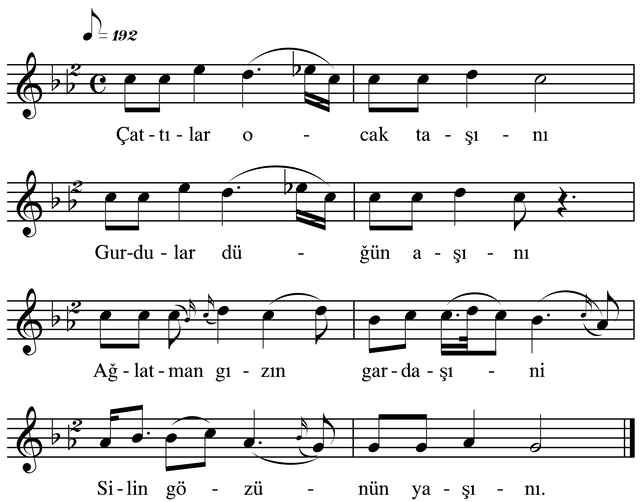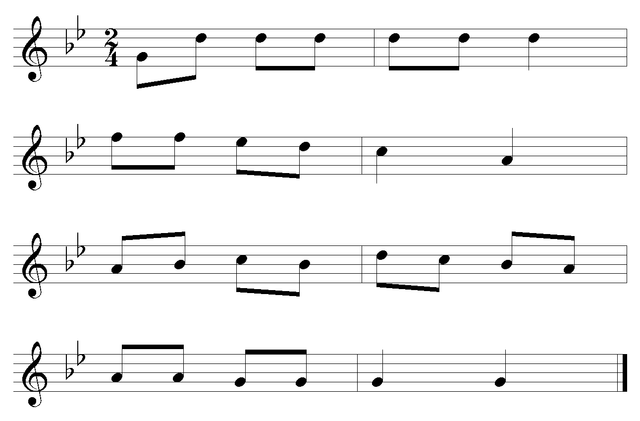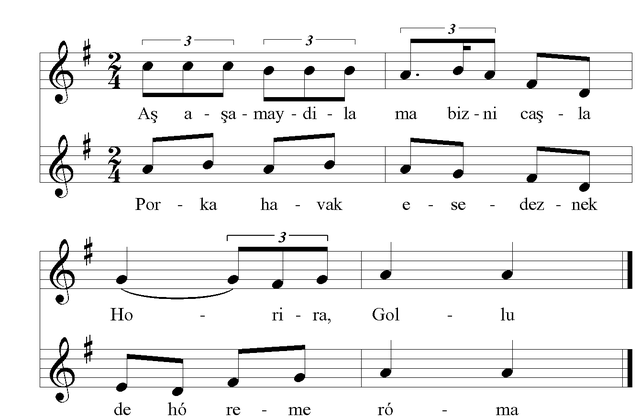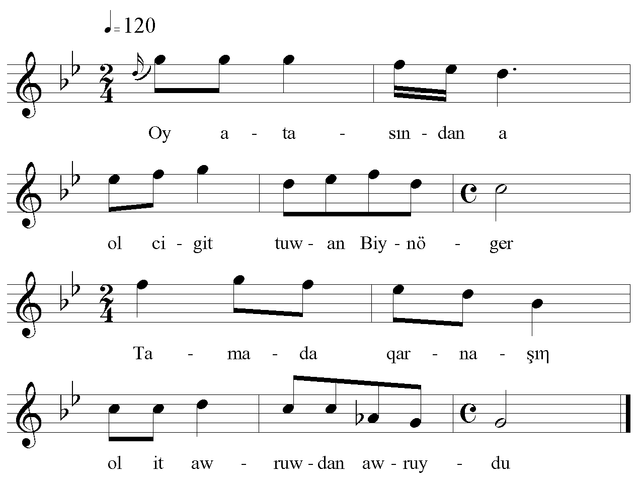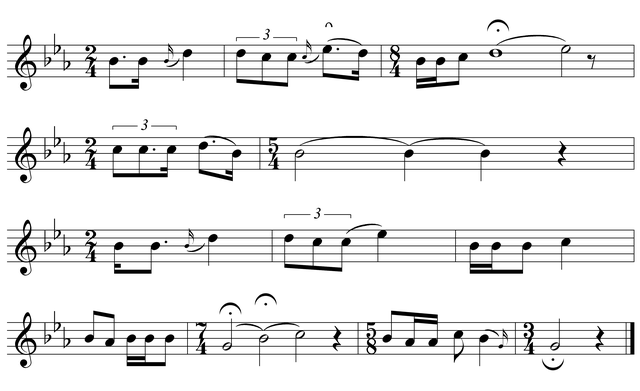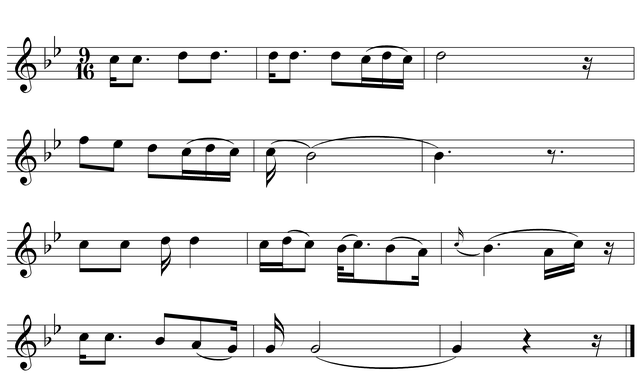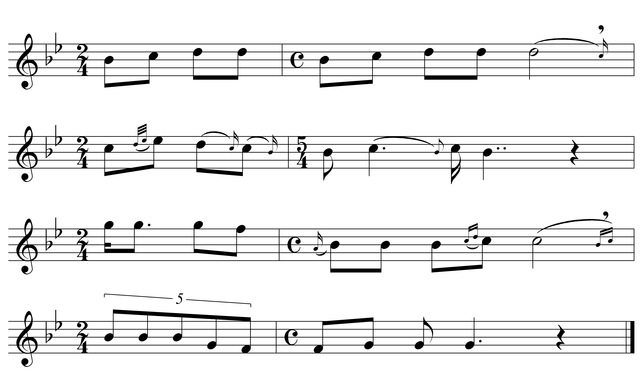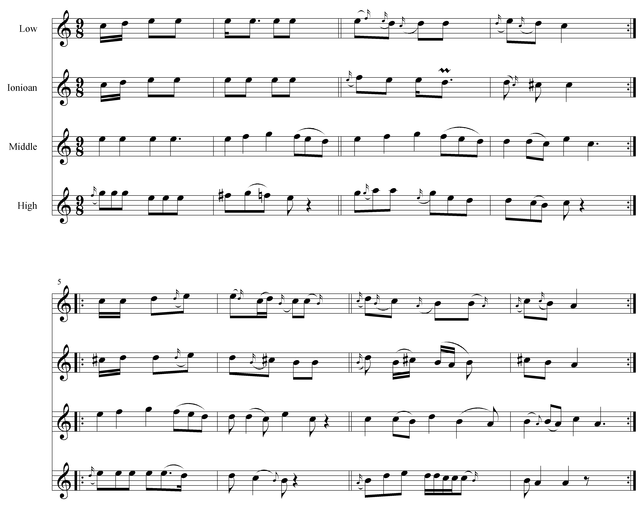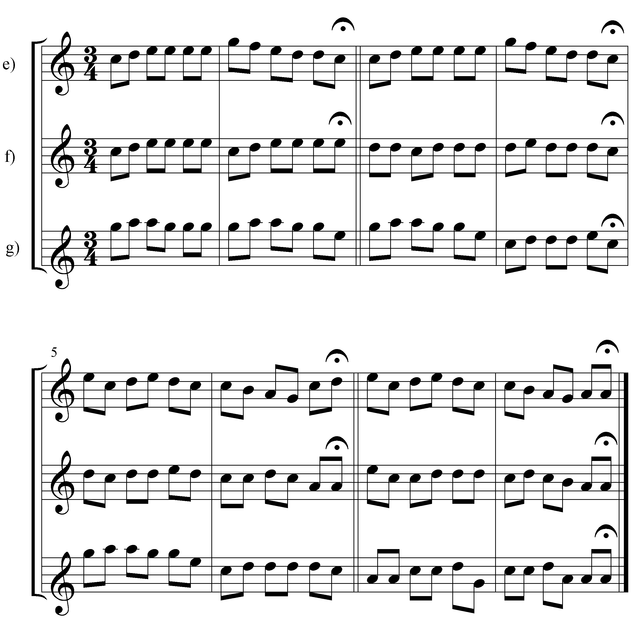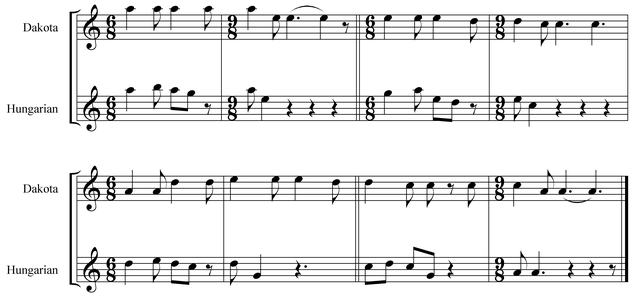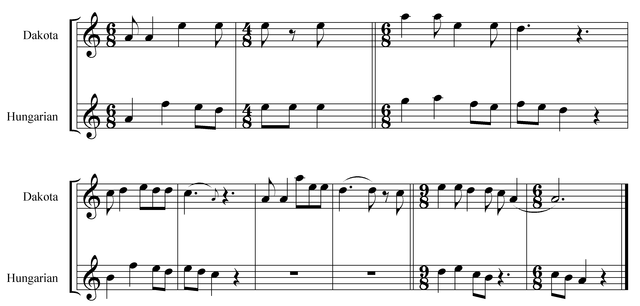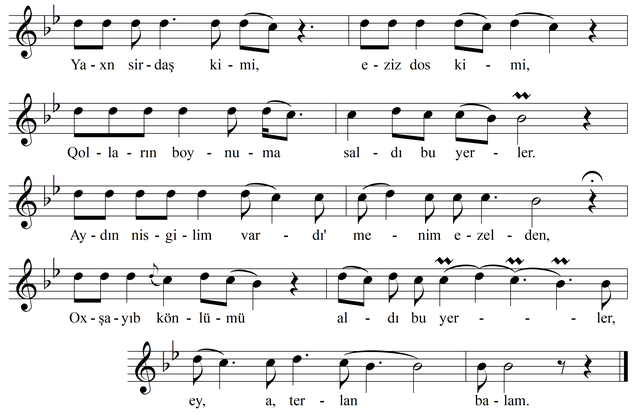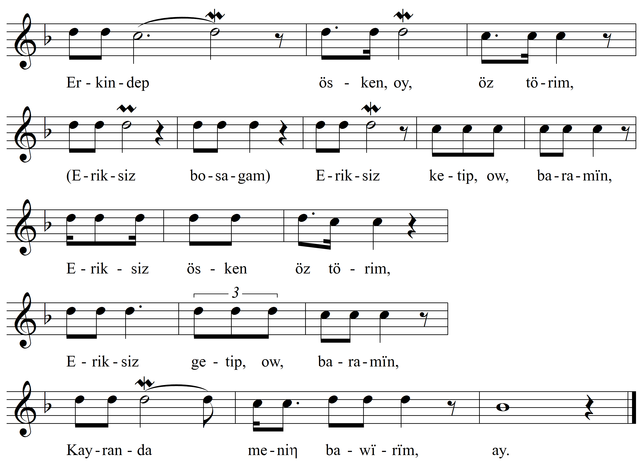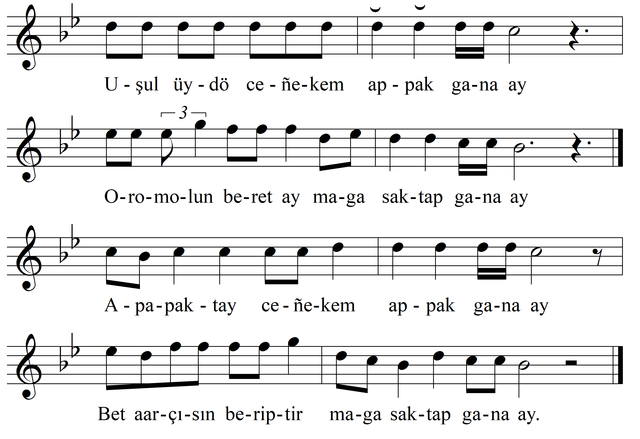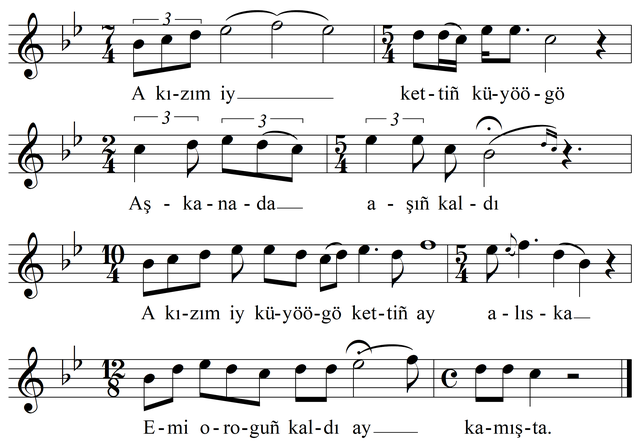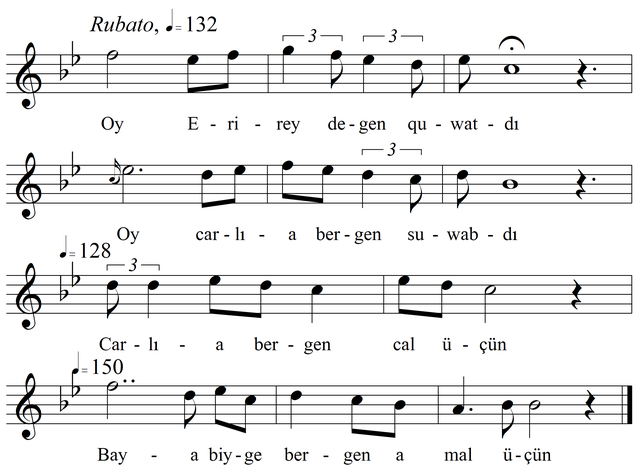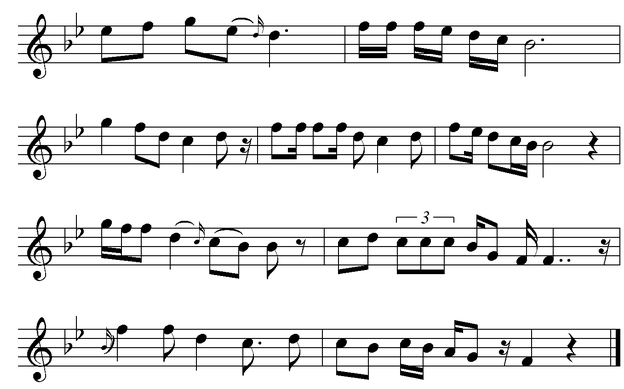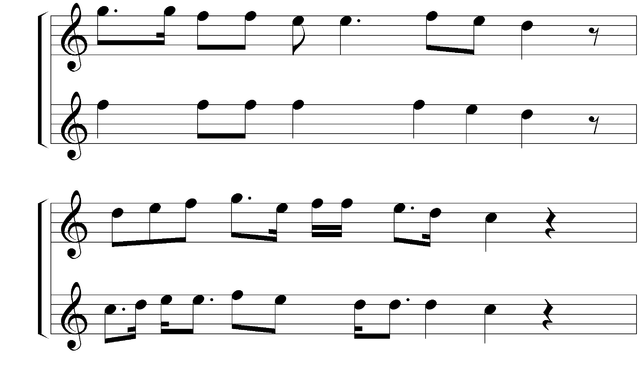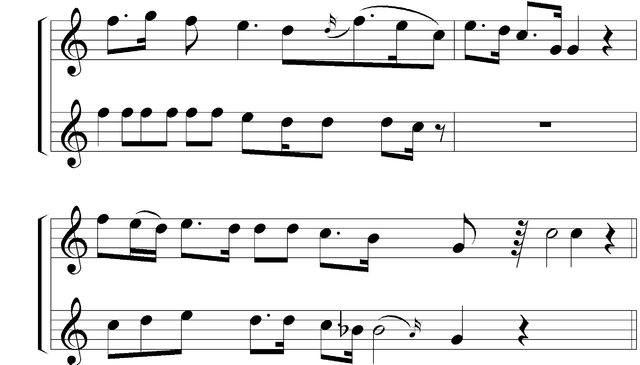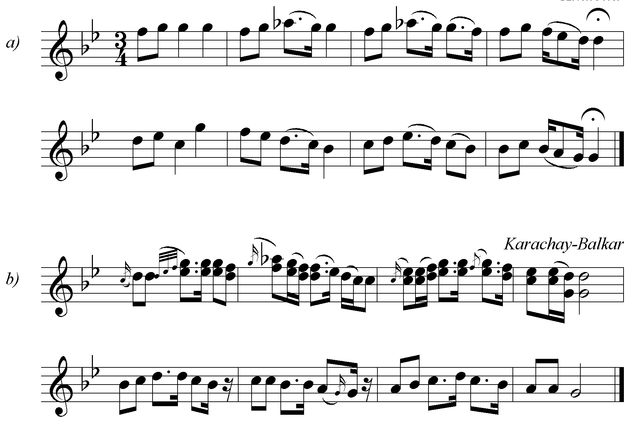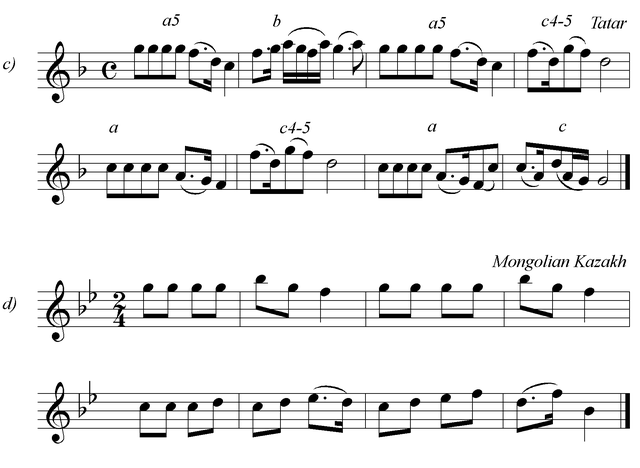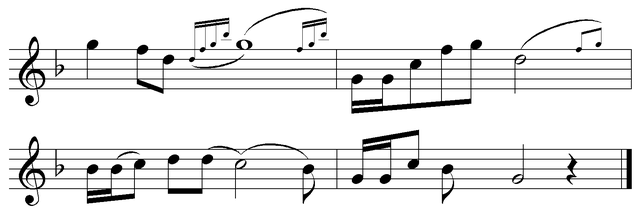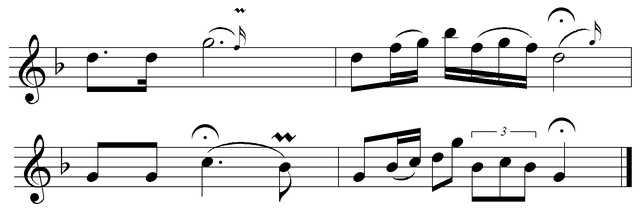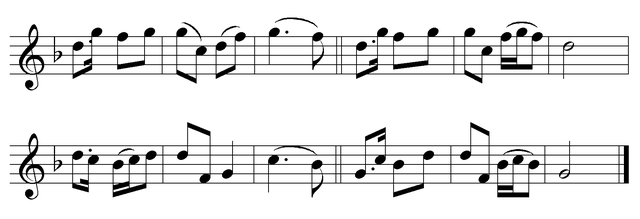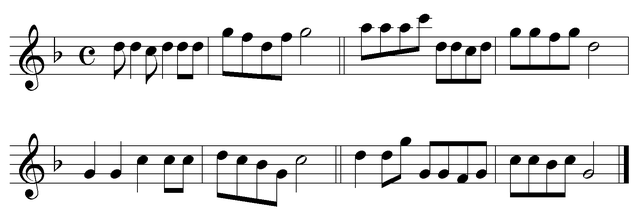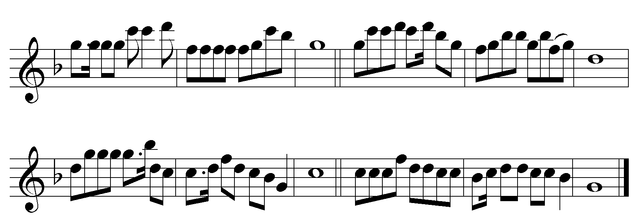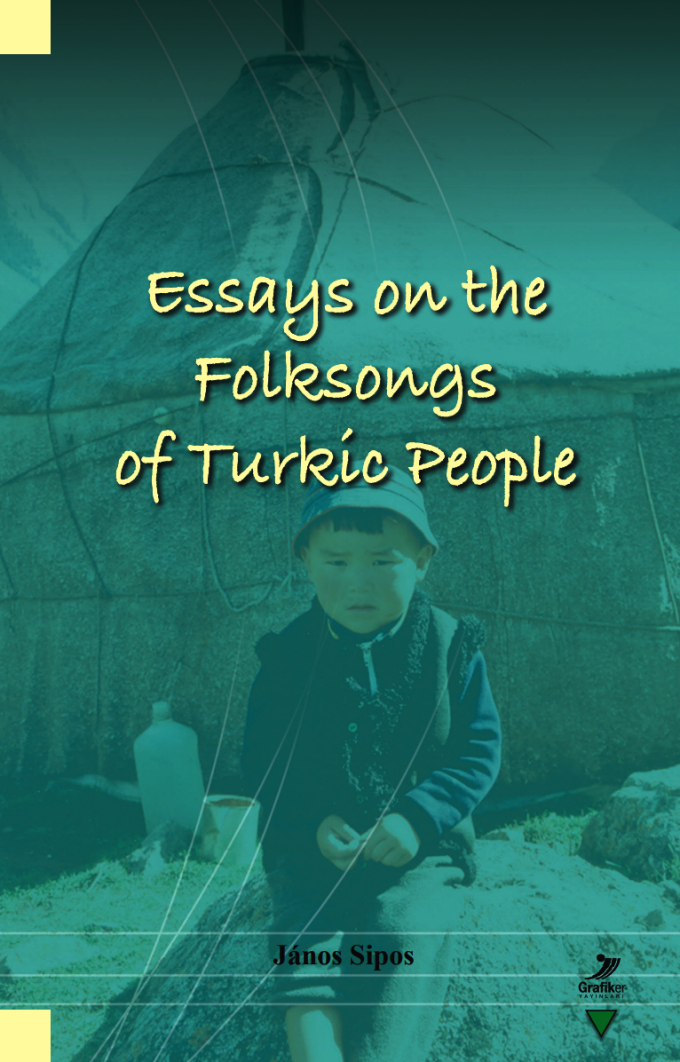
János Sipos
Essays on the Folksongs of Turkic People
Technical preparation of the E-book: Adrienn Ádám
Programming: Zsolt Kemecsei
ISBN: 978-615-5167-64-5
© HUN-REN Research Centre for the Humanities Institute for Musicology 2024
© János Sipos 2024
Using the E-book
This E-book is an electronic version of the volume quoted above. You can click on the symbol ![]() to listen to the sound and click on
to listen to the sound and click on ![]() to see video recordings.
to see video recordings.
Using the e-book is facilitated by a tool box in the lower left corner: after the search bar, the second icon jumps to the table of contents, while the third icon allows you to print the book or part of it.
About the author
Prof. Dr. János Sipos is professor at the Liszt University of Music, the Hungarian Representative of the International Council of Traditional Music, senior research fellow of Institute for Musicology, and Member of the Hungarian Academy of Arts.
His main research area is the comparative study of the folk music of Turkic speaking pople and also exploring the Hungarian relations. His collecting work began in 1987, where Béla Bartók stopped in 1936, and since then he has collected, recorded and analyzed more than ten thousand Turkish, Azeri, Turkmen, Karachay, Kazakh, Kyrgyz, Navajo and Dakota melodies. His 18 books, 168 articles and hundreds of hours of video and audio recordings can be viewed at www.zti.hu/sipos.
Contents
 A Folk Music Research Series Among Turkic People (1936-2019)
A Folk Music Research Series Among Turkic People (1936-2019) About the Folksongs of Some Turkic People
About the Folksongs of Some Turkic People Dakota Folk Songs and their Inner-Asian Connection
Dakota Folk Songs and their Inner-Asian Connection Ancient Hungarian musical styles and their connection to the folksongs of Turkic people
Ancient Hungarian musical styles and their connection to the folksongs of Turkic people An Inner Mongolian pentatonic fifth-shifting style and its relevance to Hungarian and
An Inner Mongolian pentatonic fifth-shifting style and its relevance to Hungarian andVolga-Region folk music
 About the first analytic and comparative monograph written on the folk music of the
About the first analytic and comparative monograph written on the folk music of theKarachay-Balkar people
 References
References Bibliography of János Sipos
Bibliography of János Sipos Endnotes
Endnotes
A Folk Music Research Series Among Turkic People (1936-2019)
Hungarian prehistory displays a peculiar duality of language and music: the language belongs to the Finno-Ugric family, while several pre-Conquest strata of the folk music are connected to Turkic groups. Intrigued by this phenomenon, Hungarian researchers launched thorough comparative examinations quite early; to mention but the most important scholars: Zoltán Kodály demonstrated Cheremis and Chuvash analogies in the first place; Lajos Vargyas carried out the comprehensive historical investigation of the folk music of the Volga-Kama region; Bence Szabolcsi demonstrated even broader international musical connections after surveying an enormous material; Katalin Paksa studied the eastern relations of our narrow-range tetra- and pentatonic tunes and László Dobszay with Janka Szendrei applying a novel approach to the Hungarian folk music material reviewed the international material in regard to the lament and psalmodic styles, among other things.
In keeping with the noblest traditions of Hungarian folk music research, investigations authenticated by fieldwork have been going on to this day parallel with theoretical research. Most important among them are Béla Bartók’s Anatolian collecting in 1936, László Vikár’s and Gábor Bereczki’s areal field research in the territory designated by the Volga, Kama, and Belaya rivers in 1957-1978, and my field research activity among several Turk ethnicities since 1987 till now.
At the beginning, the main goal of this research series was to explore the eastern relations of the Hungarian folk music, which gradually broadened into the areal research of the multi-ethnic Volga-Kama-Belaya region. I further expanded it into the comparative investigation of diverse Turkic-speaking groups living over the vast Eurasian territory. In the meantime, the study of Hungarian prehistoric connections was also going on.
It justifies research into Turkic folk music that these ethnic groups have long been playing salient roles in Asia, and without the exploration of their music the musical world of Eurasia cannot be comprehended. What makes this research even more interesting is the fascinating diversity of their music as well as the fact that the connections between the music of these Turkic groups fundamentally differ from their linguistic relations.
In the course of this enormous work a part of the musical map of this vast area stretching from China to Eastern Europe has been plotted. It is also a fact that no similarly extensive, analytic, comparative folk music research based on field work has been carried out earlier in Asian territories.
Summary of the research task
The long-term goal of my research is to systematize and compare by musical criteria the traditional songs of Turkic groups and other ethnicities living among and around them. I rarely touch on instrumental folk music, the repertoire of professional performers, the most recent strata, seldom or just occasionally discuss art music and the cultural, social, and anthropological implications of music are only sporadically considered, too: I concentrate on traditional folk songs.
There are close connections between the languages of Turkic groups, but their musical stocks are fundamentally different. That is not surprising, because these people are, at least in part, Turkified, and through their substrata they are in genetic and cultural relations with several non-Turkic peoples. My research therefore has repercussions; apart from the Turkic-speaking peoples tied by culture, language, and history, upon their neighbors and partly absorbed other peoples, creating the foundation for even broader future comparative ethnomusicological research of Eurasian groups.
This paper is aimed to provide a summary about the findings of my field research into the folk music of Anatolian Turk, Azeri, Karachay-Balkar (in Northern Caucasus and Turkey), south-western and Mongolian Kazakh, Turkmen, Uzbek, and Kyrgyz people between 1987 and 2019. In some articles I gave detailed account of the phases and results of collecting work, analysis, and comparative research.
Description of the performed tasks, methods of processing, sources
There were no systematized archives for the investigation of Azeri, Karachay-Balkar, Kyrgyz, Aday and Mongolian Kazakh, Turkmen, and Sufi Islamic music, while the Anatolian and Kazakh collections were hardly accessible. Besides, the material of the latter was poorly annotated; basic genres were missing, such as laments, lullabies, folk religious tunes. That was why I had to carry out extensive field work among several Turkic ethnic groups.
In the past 30 years I spent a total of some 10 years in areas populated by Turkic groups and collected and notated more than ten thousand tunes. I worked mostly in small villages and finished collecting among an ethnic group when the newly recorded tunes were already variants of former ones. The created Turkic archive belongs to the major systematized and elaborated collections of Azeri, Kyrgyz, Karachay and Turkmen folk music anywhere in the world. Concerning the degree of notation and analysis, the Anatolian and Kazakh sections are also important. This large number of tunes allowed us to draw unique and reliable conclusions, and the whole endeavor acquired the value of basic research.
The main groups of tunes I have collected since 1987 are the following: Turkish in Turkey (c. 4000 tunes), Azeri (600), Caucasian and Turkish Karachay-Balkar (1200), western and Mongolian Kazakh (600), Kyrgyz (1300), Turkmen (500), Sufi Islamic communities (700) and North American Indian (700). My investigations covered other non-Turkic peoples and religious communities of the area (1400 tunes). The entire collected material is summarized under “The archives” on my website.
The majority of collected tunes are videotaped, a considerable part of the collection has been digitalized; cataloguing and uploading them online are in process. I notated the Anatolian, Azeri, Karachay, Kazakh Kyrgyz and Turkmen tunes and presented large representative selections together with audio- and video-recordings in my books.
In addition to the works of Hungarian researchers in the Volga-Kama area and their followers some articles and even a few books have appeared on the folk music of some Turkic groups I studied thoroughly (Anatolian, Kazakh). In many cases, however, there are only tune selections (Azeri, Karachay, Kyrgyz) or not even that (Turkmen). I have studied the local and foreign folk music researchers’ works the great majority of which refrain from classification, let alone comparative examination. I touch on these in the discussion of the respective group of people. Let us mention some scholars who make at least partial attempts at comparison: Robert Lach, Béla Bartók, Viktor M. Beliaev, Viktor S. Vinogradov and Kurt Reinhard.
In my work I have applied the methods of comparative folk music research with great Hungarian traditions, of which László Dobszay wrote in one of his important articles. I resorted to the methods of ethnomusicology adapted to the currently predominant cultural-social anthropological trends in smaller communities such as the Sufi Takhtajis and the Alevi/Bektashi communities, as well as for in-depth research among the Aday and Mongolian Kazakh people. During fieldwork I did numberless interviews with musicians which are still to be processed.
I notated the collected tunes and classified them relying on the methods applied by my predecessors to the arrangement of Turkic folk music tunes. When comparing the material with Hungarian folk music, I primarily used Dobszay-Szendrei’s (1992) conception of styles.
The used symbols and the principles of transposition and musical systematization are described in the introduction of my books where I also explain why I could not choose strictly unified principles for the classification of the examined folk music materials. Let it suffice to note here that the significantly different musical materials required different criteria of classification. For instance, the Azeri, Turkmen, and Uzbek songs have short lines of a few neighboring tones as against broad-ranged four-lined pentatonic folksongs implying fifth-shifting. The main criterion of the systematization is first the melody line because the rest of the musical features (e.g., rhythmic scheme, syllable number, gamut, etc.) are less markedly characteristic of the tunes, and the grouping on their basis can easily be presented in tabular form.
The examined Turkic folk music stocks of the Anatolian Turkish, Sufi Turkish Bektashi of Thrace, Azeri, Turkmen, Uzbek and Tadjik, Karachay-Balkar, Kazakh and Kyrgyz relying on the material of my expeditions, as well as that of the Turkic groups in the region demarcated by the Volga, Kama, and Belaya, relying especially on the works of Lajos Vargyas and László Vikár (References).
Summary of the new scientific results
I can only list here some of the observations and findings about the folk music of different Turkic peoples and their relations to Hungarian music; these are expounded in more detail in the discussion of the music of individual groups in my books.
Of similar significance to the systematic collection of the enormous material is the analysis and classification of the musical repertoires, which provides a unique possibility for a musical review of the studied segments of folk music. The music classes can be study in details in my books (References).
Based on publications and collections by other scholars, I also reviewed the music of Turkic groups not mentioned analyzed here in details (e.g., Siberian Turk, Gagauz, Karaim, Crimean and Dobrudjan Tatar, Uzbek, Tadjik, Uyghur, and Yellow Uyghur groups) to which I make some reference at most; their inclusion into comparative research will be the task of a subsequent stage of research, or of a new generation of researchers.
There is little connection between the Turkic peoples’ linguistic and musical relations, probably owing to the different substrata. E.g., compared to the highly complex forms of Anatolian folk music the linguistically closely related Azeri folk music has just a few musical forms, and these have hardly any connection with the simpler forms of Anatolian folk music. Similarly, compared to the simple narrow-range diatonic tunes of southwestern Aday Kazakhs, the music of Mongolian Kazakhs living several thousand miles away from them is dominated by pentatonic tunes of passionately undulating melody lines, although the language of the two groups is practically identical.
Several complex Turkic folksong repertoires contain contradictory musical strata of different origins (e.g., Anatolian Turkish, Karachay, Kazakh and Kyrgyz), and at the same time, in the music of nearly every Turkic group the rate of one or two-lined simple forms is significant, and some repertoires are wholly traceable to these simple forms (e.g., Azeri, Turkmen).
Anatolia’s particularly complex and varied folk music is obviously largely a reflection of the ethnically mixed Byzantine area occupied by the Turks. This is the most complex of all Turkic song stocks, taking a distinguished place in the list of the world’s folk musics in terms of diversity. The songs of the linguistically closely connected Azeri, Uzbek and Turkmen people are predominantly simple, narrow-range tunes pointing to Iranian and in part Caucasian relations.
The music of Karachay-Balkar and Nogai people living on the northern slopes of the Caucasus is far more complex than that of the Southern Caucasian groups and it differs in its strata as well. In the former music there are several musical layers that can be found among neighboring Caucasian groups and were presumably borrowed by the Turkic groups from them. The music of the Azeris more to the south of the Caucasus displays strong Iranian influences (too).
Kyrgyz, and particularly Kazakh folk music is also complex, but it comprises different strata than the Anatolian music. The pentatonic strata of the equally diverse Uyghur and Yellow Uyghur folk music lead over to the musical realm of northern Turkic – Mongolian – Chinese music.
The zone of pentatonic Turkic music stretches from China through the Uyghurs, Mongolians, South Siberian Turkic groups, and the northern and eastern Kazakh areas to the Chuvash, Tatar, Bashkir people in the Volga-Kama-Belaya area, and characterizes most of the old (and some newer) strata of Hungarian folk music. Among the northern and eastern Turkic groups only the music of the Yakuts (Sakhas) living scattered over an enormous area to which they arrived relatively late is not pentatonic. However, the Turkic tunes using pentatonic (and partially pentatonic) scales take a great variety of forms, and the different pentatonic scales are not represented with equal weight in the repertoires of different peoples, aptly illustrated by the common and different strata of e.g., the Cheremis, Chuvash, Tatar, Bashkir, and Mongol folk music. The pentatonic phenomena of Russian, Finno-Ugrian and other peoples must be subject to a different research program.
The Turkic ethnic groups living more to the south have predominantly diatonic folk music of narrow-range simple melodies. Mainly in Anatolia and some central and southern Kazakh and partly Kyrgyz areas can one come across more complex, non-pentatonic tune forms. In harmony with that, the use of micro tones is more frequent in the southern Turkic areas (Anatolian Turkish, Azeri, Turkmen, Uzbek music), being less dominant in the middle strip of the territory (Karachay-Balkar, Kyrgyz, Kazakh areas) and is negligibly rare in the pentatonic belt. Within diatonic scales, the minor character scales are overrepresented among the studied groups, while scales with the major third (mostly of Major or Mixolydian character) are found among the Karachay-Balkar and Kyrgyz people in greater proportions.
Despite major differences among individual Turkic folk music repertoires, some common musical traits and even musical strata can be observed. In an article I compared the fifth-shifting tunes of Turkic groups around the Volga-Kama-Belaya and of other Turkic peoples, Hungarians, and Mongolians, and also outlined the Turkic background of the Hungarian (and international) lament style, psalmodic, descending pentatonic and fifth-shifting tunes as well as songs of children’s games. By way of an example, I mention the narrow-range simple-form Phrygian tune group of two short lines, which do not coalesce into a massive stratum in Hungarian folk music but are saliently important in Anatolian, and particularly in Azeri, Turkmen, Uzbek and Aday Kazakh folk music.
Grouping of Turkic folk music stocks, Hungarian connections, and the situation of comparative research
Before presenting the summary tables let me repeat that repertoire of Turkic folk music are often related to the music of neighboring groups and people they have integrated. In the south there are strong Iranian contacts (Azeri, Anatolian, Turkmen, Uzbek), in the north and east relations to the more broadly arched pentatonic music of the Mongols can be gleaned (Mongolian and eastern-northern Kazakhs, some Siberian Turks, Chuvash, Tatar, Bashkir), while in the region of the Caucasus musical fusion with the Cherkes, Kabard, Alan and other Caucasian peoples can be observed (Karachay-Balkar, Nogai). The music of Turkey (also) mirrors the culture of absorbed and Turkified substrata to a great extent, the music of Siberian Turkic groups is basically pentatonic but their music so fundamentally differing from the pentatonic forms of the Mongolia – Volga-Kama area requires further thorough comparative investigations. The motivic organization in the music of the Yakuts, who migrated to their current area later, also needs further studies as this music differs from the other Turkic repertoires and has forms that are like the motivic music of some Finno-Ugrian groups living at the Volga-Kama area).
Table 1 gives a grouping of Turkic folk music stocks I have overviewed. Group 1 includes the Anatolian Turks with their highly complex and basically diatonic music, showing only some pentatonic traces. Group 2 includes the Azeris who are closely tied to Caucasian and Iranian traditions, and the Turkmens with strong Iranian musical impacts. The folk songs of these people consist of very simple melodies moving on a trichord or a tetrachord. In Group 3 the Uzbeks with strong ties to the Iranian Tadjiks can be seen as a separate entity, though their songs show some similarities to the simple melody styles of the Azeris and Turkmens. In Group 4 there are the Karachay, Nogai and Kumuk people. With their composite and convex melody repertoire these folk musics, on the one hand, interacts with that of the neighboring (non-Turkic) Kabard people, and on the other hand with some important musical layers of the southern and western Kazakhs, Anatolian Turks and Kyrgyzs living far from them. Group 5 comprises the northern Turkic groups with dominantly pentatonic music: Chuvash, Tatar, Bashkir, some Altay Turk, Oirat and Tuvan people, with close relation to the pentatonic practice of Mongols and Buryats. Group 6 includes the Kazakhs living over a vast territory with their highly compound folk music displaying ties toward the diatonic music of the south and the pentatonic styles of the Turkic east. Group 7 includes the Kyrgyz, Khakas and several Altay tribes. Despite to their common nomadic background the music of groups 6 and 7 shows remarkably differences.
|
|
|
● 5. Chuvash, Tatar, Bashkir, some Altay |
|
|
|
|
● 4. Karachay,
|
|
|
|
|
● 1. Anatolian |
● 2. Azeri (~Caucasus) |
● 3. Uzbek |
● 6. Kazakh |
● 7. Kyrgyz, Khakas |
Table 2 illustrates that in the music of which examined Turkic repertoire certain old Hungarian folk music styles can also be demonstrated. This is discussed in detail in different chapters of my books and in the books of László Vikár.
|
Hungarian folk music form/style |
similar Turkic forms |
|
small form of lament |
Anatolian Turk, Azeri and Kyrgyz; to lesser extent: Karachay-Balkar, Turkmen, Aday Kazakh and Tuvan |
|
pentatonic descending tunes, including fourth- and fifth-shifts |
Volga–Kama–Belaya-region (Chuvash, Cheremis, Tatar), Mongol, Uyghur, Yellow Uyghur; to lesser extent: Karachay-Balkar |
|
psalmodic tunes |
Anatolian Turkish, Aday Kazakh, Karachay-Balkar, Caucasian Avar |
|
tunes built of twin-bar motifs rotating around the middle note of a trichord |
Anatolian Turkish; to lesser extent: Karachay-Balkar. This type can be found Azeri dance tunes too. |
|
’regös’ (minstrel) tune |
Karachay-Balkar |
|
returning (domed) structure |
Karachay-Balkar, Kyrgyz, Anatolian Turkish and Kazakh. This form seems to be a newer development in Turkic music. |
Table 3 is meant to demonstrate the situation of Turkic folk music research did by Hungarian scholars. Thanks partly to Hungarian researchers; we have a relatively clear picture of Oghuz, Kipchak and Chuvash folk music. That is promising because considering their numeric rate, state-creating ability, and the size of the area they populate, these ethnic groups comprise the bulk of the Turkic-speaking populace. In the table, I indicate my collections in normal bold type, Vikár-Bereczki’s collections in italicized bold type, and the groups whose music has not been included in the comparative research yet are put in parentheses.
|
|
language group |
location |
|
|
I.1 |
Oghuz |
south-west |
Turkish, Azerbaijani, Turkmen, (Gagauz) |
|
I.2 |
Kipchak |
north-west |
Kyrgyz, Kazakh, Karachay, Balkar, Bashkir, Kazan Tatar, (Crimean Tatar, Karaim, Karakalpak, Nogai, Kumyk) |
|
I.3 |
Turkestani |
east |
Uzbek, (Yellow Uyghur, modern Uyghur, Salar) |
|
I.4 |
Siberian |
north |
(Siberian Tatar, Altay, Shor, Chulim and Abakan Tatar, Khakas, Tuvan, Karagas or Tofa) |
|
I.5 |
Khalaj |
|
|
|
I.6 |
Yakut |
north |
(Yakut) |
|
II. |
Bulgar-Turkic branch |
Volga-Kama area |
Chuvash |
Of course we know that the ethnogenesis of Turkic peoples seldom has been a tidy process. Many of theem have multiple points of origin, with ethnie layer placed on top of ethnie layer. Athough there are many ancestral elements shared in common by a number of Turkic peoples (e.g., Kipchak elements found among among the Uzbeks, Kazaks, Kyrgyzs, Karakalpaqs, Nogais, Bashkirs etc.), the proportions of the common elements entering each varied. Moreover, some of the shared elements (e.g., the Kipchak) were themselves hardly homogeneous. In addition, many bad or developed unique combinations of elements which helped to distinguish one from the other.
Besides folk music research, as part of the social sciences, cannot propose finite, petrified theories, and research into the music of Turkic ethnicities is far from being completed. Not only are entire ethnic groups missing, but several tasks are still to be done concerning the already studied musical stocks as well.
Collecting work must go on, the relics of traditional tunes and the contemporary repertoire must be surveyed. It is important to create large, well-documented, accessible (online) digitalized archives; to monographically elaborate the music of certain regions and ethnic groups; to carry out the comparative analysis of the tune stock of Islamic folk religion, among many other tasks. It remains for future research to involve the folk music of Turkestani and Siberian Turkic groups, of smaller Khalaj and Yakut communities, and to continue the Kazakh and Anatolian research. Most of these tasks await local colleagues and international work teams such as the Music of the Turkic-speaking World ICTM Study Group I founded.
Despite the many tasks ahead of us, I hope that proceeding along the path signposted by our great predecessors; our results in the collection and comparative analysis of the folk music of this enormous area have contributed to its better understanding. I also hope my investigations will be of help to the practitioners of comparative folk music research and ethnomusicologists adopting the methods of cultural anthropology alike, so that the foundations of an even broader comparative musical research of Eurasia involving even more ethnic groups shall be firmly laid. The review of the folk music of the vast Eurasian territory may also provide data for the confirmation or, conversely, the modification or reconsideration of some results of the prehistory of Hungarian folk music. Finally, a classified, systematized folk music material may help music education, and a large folk music database provides the possibility to illustrate the musical culture of the peoples concerned.
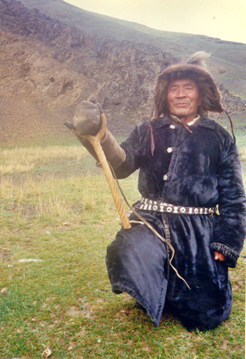
About the Folksongs of Some Turkic People
Let us now survey the main musical styles of some Turkic groups, trying to find out what characterizes only a few or a single people, and what can be explained within a ‘stylistic community’. Here, I cannot embark on the description of each folk music style, but I assess the most important folk music layers to try and define the mutual places of the Turkic folk music repertoires with a glimpse of the music of some non-Turkic neighbors.
Anatolian Turks
The population of nearly 80 million people living in the area is highly complex, and hence their folk music culture is also varied. Apart from diverse groups of Turks and Turkified people, there are Kurds, Laz, Greek, Azeri, and several other ethnic minorities. Many kinds of musical forms crop up ranging from motifs moving on a few notes to descending four-lined structures spanning two octaves. Great differences can be discerned by geographic regions and genres, too: while the folksongs of the Sufi Takhtajis in the Taurus Mountains belong to a single melody group, their religious repertoire includes several fundamentally different forms. Despite that, a survey of Anatolian folk music is not hopeless. Béla Bartók tried in 1936, and I have surveyed a far larger material myself, too (Sipos 1994, 1995, 1997, 1997).
There are strong musical connections between the Hungarian and Anatolian psalmodic style, the lament style and the tunes of children’s games. Hungarian research derives the psalmodic tunes from European origins, the tunes of the small form of the lament style are thought to be a Finno-Ugrian legacy, and the children’s game songs of mi-re-do notes rotating around the middle note are known to arise among most diverse ethnic groups independently of each other. My recent investigations tend to suggest that the Anatolian tune types should be conceived as the heritage of the basic Byzantine population tinted with Turkic and other influences. It is an important difference that as compared to several Hungarian musical strata, the Anatolian music is essentially and almost exclusively diatonic.
In addition to diatony, an important feature is the conjunct motion of the melody which develops along neighboring notes and the first half of the tune does not get separated from the second in terms of pitch zone. Despite its variety, these features lend some homogeneity to the great part of the repertoire of the Anatolian region. A disjunct structure, “small fifth-shifting” or fifth-shifting only occur sporadically, almost by accident only between the lines within the overall descending tendency. A typical feature is the sequencing of lines or bars in several tunes, and even styles (Example 1). There are hardly any tunes of architectonic structure, and if there are some, they are far less developed than their Hungarian counterparts.
Typical of Anatolia is the diversity of asymmetric rhythms whose ancient European (Greek) origin is alluded by to their primary (but not exclusive) presence along the seashores once populated by the earlier Greek city states and their environs. A few asymmetric rhythmic schemes also occur in the music of the Turkmen tribes of the Taurus Mountains, as well as among Turkmens, Uzbeks, Uyghurs, but are missing from the folksongs of other Turkic groups except for the repertoire of some bards.
The tunes are performed in both free and strict manners, their construction is basically authentic, the last note most often being the lowest pitch as well. Most songs is 2-lined or 4-lined or derives from these formulae. Scales with the minor third are predominant, but degrees 2 and 6 are more unstable than the rest, intoned somewhere between the minor and major third and sixth, resp. degree 2 is practically never absent, while degree 6 is often missing from the scale.
In Anatolian folk music there are numberless Aeolian tri-/tetrachords and even bichord tunes—the bulk of them are one-lined or two-lined in accord with the small compass. There is a considerable number of minor (and major) pentachord tunes, several of which have analogies in Hungarian folk music (Example 2).
The compass of the Turkic tunes does not exceed seven notes (1-7), except for some South Turkish uzun hava tunes. Contrary to a generally held view, the scales with augmented seconds are rare and the augmented interval is usually between notes 2 and 3, sometimes falling just narrow of a real augmentation.
It is impossible to survey the whole repertoire of Anatolia in a few pages, but in my books, I introduced the central tunes of the main tune classes from two angles. First, I ranged them in tune groups according to cadence, length and number of lines, and the height of the first line; then I rallied the groups of similar melody motion along one long or two shorter melody lines (or two long and four shorter lines) into respective classes and demonstrated the interrelations of the classes in tables. The tables clearly illustrate which tune classes are preponderant, which are rare or missing. I also demonstrated the present the central tunes of the tune classes starting with the twin-bar forms, followed by those retraceable to one long (or two short) lines and finally those that can be traced to two long (or four short) lines. However, the detailed elaboration, comparative analysis, and historical exploration of the musical strata of the folk music of this enormous area with a population of some 80 million are still awaiting the work of contemporary and future generations of folk music researchers.
Bektashis of Thrace
I conducted a separate research among a Sufi Turkish group, the Bektashis of Thrace. They are a mystic community of Islam living in the European part of Turkey, migrating here from Bulgaria, and thus knowledge of their music allows an insight into the folksongs of both the Bulgar Turks and a Sufi religious society.
There is much concordance between the Bektashi and the typical Anatolian tunes. Bulky layers are constituted by the mi-re-do-core tunes rotating around their middle note, by diverse forms of the psalmodic style and by the sequentially descending tunes (Example 3). Not infrequently, a lengthier tune is built from a single or just two different motifs.
b) diverse form of the psalmodic style and c) sequentially descending tunes
Typical is the conjunct motion and form with descending melodies in lines of convex or descending shape. This applies both to tunes built of variants of a single short hill-shaped la-re-(mi-re)-do-(b)si-la line and to forms of many lines.
In the first line of several Bektashi tunes there is a rise-fall-rise undulation over a narrow tonal range; this is less frequent in Anatolia but can be found as typical in several Turkic groups, e.g., the jir tunes of the Karachays, among Kyrgyz, Aday Kazakh and particularly Mongolian Kazakh people, often with a wider compass, too (Example 4).
There are disjunct structures as well, but never in pure form. The domed, returning construction is more frequent than in Anatolia; detailed analysis has found these tunes to be specific to the Bektashi community, mainly belonging to their religious repertoire.
Apart from the sol’-mi-re-do-(b)si-la scale, incomplete scales are rare; most interestingly, one is the re-si-la tritonic scale of laments and bride’s farewell songs. The small form of the Hungarian and Anatolian lament is not found here.
As is typical of folk religious tunes in general, there is a close connection between Bektashi religious and folk songs. The simplest, single-line small-compass forms dominate folksongs and some religious semah dance tunes, and the wider the compass and the closer we come to four-lined structures, the greater the number of similar religious and folk tunes.
Azeris
Progressing eastward from Anatolia, one finds the closest language relatives of the Anatolian Turks, the Azeris. The area of Azerbaijan was Turkified by the same Turkmen tribes as Anatolia, but the substratum upon which they settled was different. That must be the reason why the two folk music stocks are so dissimilar. In Azeri areas the surviving of the music of a complex Caucasian and probably an even more significant Iranian basic layer can be found.
Compared to the highly complex Anatolian folk music, Azeri folk music in the country and beyond, in areas of historical Azerbaijan now in Iran, is rather simple. Melody motion is conjunct; scales with large leaps, melodies rotating around a central core, a starting ascent or tunes retraceable to a single motif or twin bar are very rare. The latter form appears at most in instrumental music.
The typically single-core or two-core Azeri tunes move in trichords, tetrachords or even bichords of Aeolian, Dorian or Phrygian/Locrian coloration, comprise 7-syllabic, 8-syllabic or less frequently 11-syllabic descending or convex lines rarely arranged into strophes. They are performed in 6/8, 2/4 or other meters based on these, in tempo giusto, rubato or parlando manner (Sipos, 2004, 2005, 2009). Longer lines and/or fixed four-lined structures only sporadically occur here.
It well illustrates the simplicity of the Azeri musical realms that the semi-professional Azeri ashiks only use the simple forms of Azeri folk music, unlike the Turkish or Turkmen bahshis (bards). More complex forms can only be found in instrumental dance music and in the courtly mugam/makam music.
The musical realm of the Azeri tunes is characterized by a plenitude of variations on the basic forms despite the great degree of simplicity.
Let me call attention to three Azeri tune groups. The tunes of one move on the notes of the (sol’-fa)-mi-re-do chords, are performed parlando, their lines end on re or do—thereby resembling the small form of the Hungarian and Anatolian laments. The weight of the analogy is further enhanced by the genre of the tunes being laments in most cases (Example 5).
(The audio examples are only similar to the notated melodies)
However, this tune type is only a subtype of major character of the Azeri laments which have three modal variants. Another group contains four-lined Aeolian tunes which fit into several Turkic and non-Turkic psalmodic styles. And a few melodies of this group have considerable Turkic and Hungarian backgrounds. However, I only met with such tunes in publications and only found similar tunes among the Avars living in Azeri areas during my field-research. Four-lined constructions are basically rare in Azeri areas, whereas, at least today, they are prevalent in the Hungarian material and characterize at least half the tunes of other Turkic (Anatolian, Karachay, Kyrgyz, Tatar, etc.) groups.
Phrygian/Locrian tune groups built of one or two short narrow-ranged lines acquired greater significance after the analysis of Turkmen (and Tajik) folk music.
The folk music of a few minorities living in Azeri territory is also revealing. I collected music among Avars, Tats, Zakhurs, mountain Jews, Russians and Hemsilli Turks. The Tats of southern Iranian origin and the Zakhurs of Caucasian roots largely merged with the Azeris, and the tunes of the basic strata of the Mountain Jews’ music who fled here from the eastern Caucasus are also practically indistinguishable from the Azeri tunes.
Different is the case of the Avar, Russian and Hemsilli Turkic songs. The Avars constitute the largest and most advanced ethnic group of Dagestan, a part of whom live in today’s Azerbaijan. Unlike the rest of the minorities there, they preserve their culture, and a great part of their songs are different from the Azeri tunes. Typically enough, about half the Avar tunes I collected more or less fits the psalmodic style. The re-do-la triton of the recorded Russian tunes was really refreshing in the consistently diatonic world.
The Hemsilli Turks migrated here from Georgia; most of their tunes are in accord with the basic layers of Azeri and Anatolian folk music, including the small form of the lament style and even a few tune variants of the psalmodic style. They have a few tunes that cannot be found either in Azeri or in Anatolian folk music.
Let us sum up at this point the Hungarian and Turkic relations of Azeri folk music. It immediately strikes the eye that compared to the seemingly homogeneous Azeri tune stock of a few elementary styles, the folk music of several (but not all) Turkic groups and the Hungarians contains many essentially different tune layers. One can find analogies to most Azeri tunes in Anatolia, the most convincing parallels coming from northern Anatolia where the rate of Kurds and Azeris is high. Unlike Hungarian and Anatolian folk music, Azeri tunes are predominated by narrow tonal ranges and the rarity of fixed four-part constructions. Besides, melodies built of trichord or tetrachord motifs rotating around the middle note are only found among instrumental tunes—and infrequently, too. What there is a profusion of in Azeri folk music are the tunes similar to the small form of Hungarian and Anatolian laments. This is perhaps the only folk music form that displays real similarities between Hungarian and Azeri music.
Owing to the absence of pentatony and large tune forms, the diatonic and narrow-compass Azeri tunes have nothing to do with the pentatonic musical layers of Tatars, Bashkirs and Chuvash people living in the region of the Volga, Kama, and Belaya. The music of the eastern Chuvash minority and the Christian Tatars includes some narrow-range motivic forms, but they are almost always tritonic or tetratonic tunes containing leaps. In this region, the Mordvin and Votyak folk music contains a few do-re-mi-re-do 3-4-note single-motif hill-shaped lines, but their character is different from the Ionian trichord Azeri tunes.
Since the forbidding mountain range of the Caucasus separates the ethnicities living on either side of it, it is not surprising that the varied folk music of the Karachays and Balkars speaking a Kipchak Turkic tongue hardly have any similar layers to Azeri music.
A bit different is the case of the Mangyshlak Kazakhs on the other side of the Caspian Sea, as they are separated by a sea, and not a mountain range from the Azeris. The central lament stratum of these Aday Kazakhs move on the same Phrygian/Locrian chords—though with a somewhat different logic—as one of the most characteristic tune groups of the Azeris. The Kazakhs of Mangyshlak have far more colorful and numerous musical styles than the Azeris, but their musical styles substantially deviate from the pentatonic musical styles of the Kazakhs in Mongolia more to the east. By contrast, a great part of the Turkmen and Uzbek (as well as Tajik) folksongs—as will be seen—display strong stylistic similarities to the central Azeri folksong types.
Turkmens
Let now us see the folk music of Turkmens on the opposite side of the Caspian Sea, across from Azerbaijan. In the ethnogenesis of the Turkmens, a considerable Iranian population took part in addition to Oghuz and Kipchak tribes, which put a deep imprint on their folk music, too.
The melody contour of Turkmen folksongs is just as simple and homogeneous as that of the Azeri tunes, verified by all available publications and my collection of 600 tunes, too. In other aspects, however, they display a rich variety, e.g., in the women’s performing style, in peculiar timbres, the use of quarter tones and special micro rhythms, etc. It is quite clear that their repertoire fully satisfies the musical needs of the community. The copious use of micro tones is more an Iranian than a Turkic heritage, also reinforcing the massive Iranian substrata of Turkmen music.
Turkmen folksongs have narrow compass, move fast, the melody line often descends from the highest to the lowest pitch, and the forms are very simple. Most tunes have two lines, and a considerable portion of the four-lined songs can be directly tied to two-lined versions (Example 6).
Some tunes recite one or two notes, but the compass of their more melodious pieces does not go beyond a trichord or tetrachord, either. They may have minor or Phrygian character or between the two using micro tones. These tunes are characterized by short lines, simple rhythmic formulae, and a descending melody outline. The only popular structuring principle is the descent of motifs in second sequences, which is also frequent in the folk music of Anatolia, but from the equally simple music of Azerbaijan it is almost wholly missing. Compared to Azeri music, Turkmen tunes are often in 5/8 meter. Despite the four-lined text stanzas, one-part or two-part half melodies are most frequent; a melody structure of four different lines is rare.
Comparison of the Azeri and Turkmen Repertoires
The simplest tunes are sung by women in both ethnic groups. By contrast, the (semi)professional singers—Turkmen bahshi, Azeri ashik—and the paid singers of weddings are mostly men.
The folksongs, ritual songs and Islamic religious tunes of both groups are simple, in 2/4 or 6/8 time, often performed rubato (sometimes parlando). Melody lines are 7-syllabic or 8-syllabic, the overall form can usually be derived from one or two lines, the compass rarely goes beyond the fourth, and tunes moving on two neighboring notes are not infrequent. Though accurate intonation is not characteristic of Azeri tunes, in Turkmen folksongs the role of quarter tones is far stronger. In both groups’ music the typical rhyme scheme is a a b a, and refrains are rare.
Nearly every Azeri tune type has its Turkmen parallel and vice versa. A major difference is that in Turkmen folk music there are considerably fewer tunes moving on Ionian tri-/tetrachords.
The Phrygian (sometimes Locrian) tri-/tetrachord plays an important role in both folk music. Similar simple Phrygian tunes are frequent among the Uzbeks, Tajiks and in Anatolia, too. In Sipos (2004, 106-115) several Azeri-Anatolian parallels are presented.
The repertoire of Azeri ashiks consists mainly of folksongs (Sipos, 2004, 116-118). In the introductory section of their performance Turkmen bahshis also sing simple tunes which, however, often have longer lines than the folksongs and gradually evolve into broader-compass intricately structured compositions. Another difference is that the Azeri ashik’s instrument is the three-stringed baglama well-known in Turkey, while the Turkmen ashik prefers the two-stringed dutar. Both ashiks and bahshis may sing solo, may accompany their singing with an instrument and may also have a small ensemble. The instruments of an Azeri ashik’s ensemble include the baglama to accompany his singing and play interludes, zurna (sometimes zurnas) and a drum. In a Turkmen bahshi’s ensemble there are one or two dutars (plucked lute) and a gijak. Complemented with the blown balaban and a drum, the latter becomes the typical apparatus of Azeri court musical mugam (maqam) performance.
The vocal pieces of Turkmen bahshis are characterized by two basic tune types: (1) narrow-ranged low-register tunes in giusto rhythm similar to folksongs, and (2) more complex tunes in a higher register. The complex forms are sometimes introduced by simple forms that can be derived from or are identical with the second half of 4-lined tunes. With the addition of refrains, the strophic structure can be enormously enlarged.
In the repertoire of Turkmen bahshis many popular Anatolian uzun hava tunes have analogies. The corresponding Turkmen tunes are heavily varied, so much so that sometimes only a tune variant of the performed cycle can be regarded as a parallel to the Anatolian tune. Besides, the cadential notes are far more blurred in the performance of a Turkmen bahshi than in Anatolia.
Both long—often additionally extended—lines of many bahshi tunes descend from high: the first line to degrees 3-4, the second to the tonic note. This scheme is frequent in the Anatolian uzun hava tunes, including the ones called türkmeni around Adana, though the latter often start the descent even higher, from degrees 10-11.
While further analyses of Turkmen folksong cannot have too much surprise in store, the deeper investigation, and analyses of the less studied and constantly changing Turkmen bahshi repertoire should be high on the agenda of folk music research.
Uzbeks (and Tajiks)
The neighbors of Turkmens are the Uzbeks, east of whom live the Tajik and Kyrgyz people. The Uzbeks speak a Turkic language, the Tajiks speak an Iranian tongue, but the two groups often lived and still live side by side on the same territory and the majority of the population speaks both languages. The music of the two groups is based on similar melodic, modal, and rhythmic foundations, many tunes having both Tajik and Uzbek texts.
Uzbek music preserves several forms that can be found among other Turkic musical stocks more to the south, whose melody line comprises both a rotation around the middle note of a trichord and the ascending or convex melody shape where Anatolian (Sipos 1994: No 45, 49) and Azeri (Sipos 2004, No 318) analogies can also be shown. Because of its improvisatory performance, scale, melody progression and cadences the Uzbek lament reminds one of the bi-cadential Hungarian and Anatolian major hexachord laments, and some laments are even analogous with the Hungarian two-lined lament scheme of minor character.
Several Uzbek laments move on the re-do-la tri-tetraton. Such tunes built of motifs are also frequent in the essentially non-pentatonic Kyrgyz (Sipos 2014), Anatolian (Sipos 1995: 79-80), and this is less surprising Hungarian music having pentatonic layers (Vargyas 2005: 0148) and in wholly pentatonic Chuvash and Tatar folk music (Vikár 1993: 107-108).
The rhymes of the Uzbek spring rain magic is recited rhythmically on varied forms of the do-do-do-do | re-sol sol motif, but not always on precisely intoned pitches. Motifs and tunes built on the re-do-sol triton can be met with in the musical repertoires of several Turkic groups, but they are rare as independent motifs in Hungarian folk music. Together with the tune on the re-do-la core these tunes allude to an ancient, pre-pentatony layer of this folk music.
There are two basic melody contours in Uzbek and Tajik folk music: (1) after a jump from the tonic to the highest degree of the scale at the beginning, the melody descends; (2) the melody traces a rising-falling outline. Less frequently undulating motion can also be found. Both melody contours can be found in simpler and more complex tunes.
Simple narrow-compass one-lined or two-lined Phrygian tunes are frequent. As already discussed at several loci, this form together with other simpler forms described in detail in Sipos (2004), presumably represents an Iranian substratum of Turkic folk music. It is also confirmed by its popularity in Uzbek and Tajik folk music.
Four-lined forms are rarer. In the discussed territory a special form of psalmodic tunes can also be spotted but only among the Tajiks and only sporadically. The melody progression of some Tajik melodies is like a few psalmodic tunes with the difference that lines 2 and 3 end on degree 2 instead of b3. Such tunes are found in the music of other (e.g., Anatolian Turkic, Kyrgyz, and Karachay) groups but they hardly ever occur in Hungarian folk music. Example 7 would pass for a Hungarian psalmodic tune, were its main cadence b3. In Tajik folk music a few disjunct structures can also be rarely found.
Karachay-Balkars
After the Azeri, Turkmen, Uzbek (and Tajik) groups using simple forms, let us move back westward, to the Karachay-Balkars geographically close to the Azeris but separated from them by the impassable Caucasus Mountains. The northern slopes of the Caucasus Mountains are important for Hungarian ethnogenesis and for many Turkic groups: this is where the steppe narrows and where the groups proceeded westward during the great migrations of the Avars, Huns, or, for that matter, land taking Hungarians.
Though less varied or rich than Anatolian folk music, Karachay music contains several different musical forms many of which have Hungarian connections. In their folk music simpler songs are underrepresented and there are many complex 4-lined forms. They have a tune class of very specific textual subdivision called jir which they regard as a typically Karachay form specific to them. However, such tunes can equally—and even more numerously—be found in the music of the Kabards, and since the form of jir tunes is so alien to Turkic music, it is justified to regard them as borrowings from the Kabards.
The typical Karachay tunes trace a descent or a hill-shaped curve in each line, and there is conjunct motion within a line stepping on neighboring notes without large leaps and without going under the cadence note. The overall form is also descending, each consecutive line moving in a bit lower zone. At the same time, it is not infrequent to have an upward leap from the fundamental note or its vicinity at the beginning of the first line, and sometimes there is some up-and-down stepping in the form of rotating around a middle note.
In the contemporary Karachay musical realm tunes built of short motifs are rare. They include the tune bouncing up and down on the fifth, and some rain incantations rotating around the mid-note of the mi-re-do trichord. The latter is a central form of Hungarian, Anatolian and Karachay children’s songs and is one of the main types of rain-making incantations. Similarly, to Azeris, Turks and Kazakhs, some tunes of the Quran recitation also rotate on the mi-re-do trichord and end on re.
Karachay folk music also contains plagal tunes with falling-rising melody contour. Such are the Hungarian regös tunes whose origins and relations have been moot questions of folk music research since the turn of the 20th century. Many regards them as vestiges of shaman rituals which incorporated Byzantine, Slavic and Caucasian influences still before the Hungarian conquest of the Carpathian Basin. At any rate, this kind of tunes (like the regös tunes in Hungarian music) are alien in Karachay folk music, but their texts—just like those of the Hungarian counterparts—allude to very ancient traditions; the genres of several pertinent songs are rain magic, lullaby, or tune of some archaic religion (Example 8).
The opposite of the typical hill-shaped or descending line forms is the concave, valley-shaped line or a line sinking to the fundamental note in mid-line. Sometimes one finds an ascending first line, too. About 10% of the presented tunes have descending or concave first lines, so these tunes are not exceptional in the Karachay musical realm, even if in the collected material their rate is lower. What is truly rare is an upward jump after a lengthier stay on lower notes, and also rare is a melody progressing on the notes of a broken chord. A line-ending leap from degree VII to b3 can sometimes be met with, and a jump down to degree V in some archaic tripodic tunes is also possible. In a few bars of several tunes there are larger skips, which deviate from the general conjunct melody progression of Karachay music.
Many Karachay tunes consist of one or two short lines and their variants. Line variants end on the same note as the preceding line, but each subsequent line moves within a narrower compass. Descending and hill-shaped, convex lines are frequent. Nearly every southern Turkic group has such melody patterns among their tunes. Owing to descent and convex line shape, grouping by cadence is satisfactory; I discuss the Karachay tunes of major and minor characters together. It well describes the structural development of Karachay folk music that even its most elementary tunes become arranged into four-line forms. The main cadence is most often (1), (2)—of lament character, or (b3) or rarer (4) or (5), the latter mainly in religious zikr tunes.
With their free performance, improvisatory treatment of the lines and descending melody contour some of the two-core Karachay tunes of major character with (2) main cadence do conjure up the realm of Hungarian, Anatolian and Azeri laments. The type that descends on a major hexachord, cadences on re and do is part of a broader musical style of rubato performance in Karachay (and Kabard) folk music including heroic songs. Similarly, to the downward extension of the end of some Hungarian laments, the melody may be enlarged, the line sequences may be enlarged in (la’-sol’)-fa-re-do › (si)-sol direction, too.
Undulation is characteristic of the lines of several tripodic tunes with (b3), (4) or (5) main cadences—this melody motion has already been seen in the music of several discussed Turkic groups.
The overwhelming majority of tunes in today’s Karachay music has four-lined forms. Below I touch on some of the most important groups.
Four Short or Tripodic Lines With (2) and (b3) Main Cadences
They descend evenly on minor character scales, from a typically higher starting line, medium-range middle lines and a lower fourth line. This summary description applies to two different subgroups. The lines of one descend with second sequences—these are apparently more recent tunes. The other very popular form has a more symmetrical, more dignified structure, its general description satisfying the criteria of the psalmodic style of Hungarian and many other ethnic folk music. A part of the Karachay psalmodic tunes are religious (zikr) tunes, but there are several lullabies, which suggests that the form is more archaic and was later incorporated in the religious repertoire. There are tunes of similar melody progression, but their main cadence is (2).
Four Short Lines With (4/5) Main Cadences and a Higher Beginning
In accord with the broader compass the melody outline is descending and sometimes exact or partial fourth-shifting and fifth-shifting can emerge, but a descent on second sequences is not exceptional, either (Example 9). The series of cadences aptly characterize the tune groups: 5(4)x, 4(5)x, 5(5)x, 6(5)4/5, 8(4)x and 7(5)b3.
Four Short Lines With (7/8) Main Cadences
The main lineament of these tunes is that their first line moving basically on degrees 7-8 may rise as high as the tenth degree and end high, on degrees 7, 8 or 9. The typical cadential series are 5 (7/8) 5 and 7/8 (7/8).
There are four-lined pseudo-domed (AB/AvarC) and domed Karachay tunes of four short lines, too. These, however, do not echo the returning structure of the Hungarian new style because lines one and three are identical or at least similar and their second line is also low. Many signs indicate that these tunes belong to a more archaic style. Some small-domed tunes have their first and fourth lines run low and the interim lines a bit higher; these also deviate from the majority of Karachay tunes.
At last, I mention a few Karachay tunes with four long lines and returning structure, in which the inner lines are a fourth or fifth higher than the outer ones. These appear to be of a more recent style and display strong similarity to some Hungarian new style tunes.
Karachay-Balkar jir Tunes
At the beginning of my field research, I took note of a peculiar tune type whose variants were found later, too, at every collection site. I gave a detailed account of them, so let it suffice here to repeat that most probably the jir style is a borrowing from the neighboring Adyghe people among whom it enjoys extraordinary popularity while no trace of it can be found among other Turkic groups.
In sum, within a broad stylistic similarity, more concrete likenesses can be discovered between Karachay and Hungarian children’s songs. A part of the Karachay-Balkar psalmodic, descending and lament tunes probably belong to the same primeval “stylistic species”—to use Bartók’s term—as the corresponding Hungarian, Anatolian, even Bulgarian, Slovakian, Romanian and some other ethnic tunes. Aside from characteristic ethnic and areal differences, the overall stylistic similarity, the closeness of individual phenomena, the melody writing, etc. urge for the continuation of research into the common origin or at least the close musical connections of these musical repertoires. A lot of Karachay tunes have convincing or more distant Hungarian analogies and historical sources permit the assumption that there might be genetic relationship between certain layers of Hungarian and Karachay folk music. At any rate, it can be declared that after Anatolian folk music it is Karachay music that displays the closest similarity to the more archaic and non-pentatonic layers of Hungarian folk music.
To be able to draw further conclusions, we should get a deeper insight into the folk music of the neighbors of the Karachays, the Osetians, Kabards and Cherkesses, which contains several similar strata to Karachay-Balkar music. One can find Kabard parallels to several tunes or even groups of the most important and most widespread Karachay-Balkar tune class, jir. The Karachay research has confirmed that the music of an individual ethnic group cannot be studied separately; the comparative examination of the culture of peoples living on wide contiguous areas is indispensable.
Kazakhs
In the area of Kazakhstan equal in size to Europe several musical researches have been conducted, but no synthesis has been completed or thorough analytic descriptions written. Beliaev (1975: 77-78) summary statement is that the Kazakh tune types rest on a common national foundation and are special realizations of the Kazakh national melody character, but Slobin (Beliaev 1975: 123) disagrees. In general, it can be stated that in addition to the regional styles, there is a great variety of tunes, a wealth of expressive details and a close connection with live speech in many Kazakh areas.
I have compared the folk music of the southwestern Aday Kazakhs and the Mongolian Kazakhs. It has turned out that despite the near-identity of their tongues, the Aday tunes move in narrow ranges along diatonic scales, as against the wide-compass pentatonic folksongs of passionate undulation among the Mongolian Kazakhs, while the latter do not resemble the pentatonic tunes of the Mongols, either. The Aday Kazakhs have more, and more diverse musical styles than the Azeris or Turkmens and their tunes substantially differ from the pentatonic musical styles of the Kazakhs living more to the east.
Let me summarize the conclusions drawn from the comparison of the folk music of Kazakhs in Mangyshlak in southwest Kazakhstan and those living in Bayan-Ölgiy area in Mongolia.
Melody contours. Apart from descending lament tunes, the first lines of Mongolian Kazakh melodies have a convex or concave curve, or a combination of the two tracing a hill-and-vale line. Also frequent are the more restless different up-and-down oscillating tunes, those reciting some neighboring tones or again others bouncing on a few notes. Though the second half of Mongolian tunes is lower than the first, one only exceptionally finds fourth or fifth correspondences between the lines.
In Mangyshlak the first line of the Aday Kazakh tunes moving on minor-character scales is typically convex; a gentler version of narrower compass can be found in the laments, psalmodic tunes and some narrow-range tunes. The first line of their wider compass two-lined la-pentatonic tunes and of the single noteworthy tune group ending on do traces a hill. This hill-shaped curve appears to be a characteristic line form that underlies the homogeneity of the Mangyshlak tunes. There are few tunes here that have a marked descent, or ascent or hill-and-vale shape. The rest of the “melodious” forms are almost wholly absent. All this widely differentiates this music from the versatile music of the Mongolian Kazakhs.
Let us compare the tunes of the two Kazakh areas since the melody progression or, more precisely, the contour of the first line.
The descending melody line of the Mongolian Kazakh laments is rare in this region which prefers finely arched lines, while the lines of the Aday Kazakh laments tracing shallow hills fit snugly among the other tunes there. The two lines progressing one under the other of the Aday Kazakh and Anatolian (as well as Hungarian) laments are structurally related with the lines ending on juxtaposed notes, but the tone sets are different. By contrast, the tone set of the Mongolian Kazakh laments is similar to Hungarian and Anatolian laments, but their structures are different. These laments can eventually be retraced to the combination of four gradually lower hill-shaped motifs. Progressing from high to low, the motifs are: (1) sol’-la’-sol’-fa-mi, (2) mi-sol’-(fa)-mi-re, (3) sol’/re-mi-re-do, (4) re-mi-re-do-si. These motifs are used by the laments of different ethnic groups as building block in the following way: Kazakhs of Mangyshlak: 1 and 1+2; Mongolian Kazakhs: 3; Anatolian Turks and Hungarians: 2, 3 and 2+3. Anatolian and Hungarian laments are closest to one another, the Mongolian Kazakh laments are like them but the realm of the Mangyshlak laments is different.
It applies to both Kazakh areas that the first line traces a well discernible hill or vale, or a clearly descending or ascending melody section. The more “melodious” lines of Mongolian Kazakhs contain two of the sections (of hill, valley, ascent, descent) at most. Repeated or varied motivic bar structures can often be discovered in these tunes: the rising-falling-rising wavy lines are often built of a b a bars. The shape that is most frequent in Anatolian and Hungarian folk music from among the mentioned ones is the hill. However, while in Anatolian and Hungarian tunes the rate of descending or stagnant lines is considerable, in Kazakh areas—except for the Mongolian Kazakh laments—such forms are rare.
The popular hill-and-vale wave in the first line of Mongolian Kazakh folk tunes also appears in Mangyshlak (South-Western Kazakhstan) but more rarely. Convex, hill-shaped first lines are massively represented in the southwestern Kazakh area, while they only occur—rarely, too—among the la-pentatonic tunes of Mongolian Kazakhs which are themselves very rare. Valley-shaped, concave first lines can only be heard among the Mongolian Kazakhs—rather infrequently and rarely in distinct form.
In both areas one can find rising first lines, but this musical solution is not frequent among every Turkic group. An ascending first line is always followed by a descending second line.
Many tunes move on the notes of bi-, tri-, or tetrachords. This may happen without clear schemes, but sometimes distinct motifs are repeated. That was seen for example with the popular psalmodic tunes of Mangyshlak whose common features are recitation on the notes of the do-re-mi trichord for a little while and the overall descending tendency of the whole melody, as well as the 5(b3)4 cadences. Such tunes are included in Anatolian and Hungarian folk music in large numbers (Example 11).
b) Anatolia (Sipos 1994: № 127), c) Hungary (Kodály 1937-1976: № 176)
Several terme tunes of Mangyshlak also belong to the recitative tunes; they are built of lines moving on two or three notes. Some of them remain on the do-re-mi trichord throughout the musical process, but some have a wider compass.
Mongolian Kazakhs also use a kind of psalmodic melody in which the first line moves in a higher register and then comes the recitation on the do-re-mi trichord. Apart from the similar melody contour, the tunes are also tied by the 7(b3)b3 and 7(b3)4 cadences; the difference is that the Mongolian Kazakh tune is do-pentatonic, the Hungarian and Anatolian examples are Aeolian in character.
The first line of many tunes in Bayan-Ölgiy moves up and down in tritony or tetratony. It is not easy to systematize these motions; what binds them together is the up-and-down steps within a fourth or fifth using the notes of pentatony (or the like). Twin bars within a line is not infrequent, and sometimes the whole tune is built of a single bar. It is important to note that such structures are often found among Mongolian Kazakh religious tunes and the tunes of a more recent style in Mangyshlak (Example 12).
In view of the enormous territory and the complexity of Kazakh ethnogenesis, it was easy to hypothesize that diverse musical dialects would be found here. Indeed, while the Kazakh tongue is surprisingly homogeneous despite the dialects, in music the divergences are considerable. According to Beliaev (1975) there are three main dialectal areas. The tunes of South Kazakhstan (the Semirechye, the area of Lake Aral and the Sir-Darya) are characterized by formal simplicity and rhythmic regularity. In the West, beyond the Ural and along the Caspian Sea lyrical solutions are predominant with broad melodies of wide compass, and the presence of termes and recitative forms is also typical. In the central parts of Kazakhstan there is a special wealth of tunes, advanced melodies, and complex verse forms.
The do-pentatonic and sol-pentatonic tunes of Mongolian Kazakhs are closer to the pentatonic Mongol-Tatar tune style, while most West Kazakhstan tunes move on scales including the minor third that are so popular in Anatolia (and in Hungarian areas). Data indicate that the music of Kazakhs in China is like the music of Mongolian Kazakhs with several variants in diverse areas of today’s Kazakhstan. In the two regions I studied the “closer” ethnogenesis was quite apparent, and probably that accounts for the fewer and relatively more homogeneous musical style. This is in sharp contrast with the extraordinary diversity of the Anatolian or Hungarian folk music.
Intricate relations have been discovered about the Kazakh laments. Some threads tie the Mangyshlak lament to its Anatolian counterparts, others connect the Mongolian Kazakh laments to Anatolia. At the same time there is—so far a single—Mangyshlak lament which almost perfectly tallies with the small form of the Turkish and Hungarian lament. It is an important finding that the tunes of psalmodic character are also widely popular in Mangyshlak, too. Many of the other similarities and differences derive from the fact that in Bayan-Ölgiy the do-pentatonic scale is prevalent while in Mangyshlak diatonic scales with the minor third is. Pentatony goes together with the agility of the tunes and decisively influences their character. This is also an aspect of the folk music of Mongolian Kazakhs that compares it to Chinese and Mongolian music, to the tunes in the Volga-Kama region and in some Hungarian pentatonic styles, while the music of Mangyshlak is closer to the Anatolian Turks, Turkmens and Azeris.
The folk music of the southwestern Kazakh area has not much in common with the broader ranged, mostly pentatonic Chuvash, Tatar, Bashkir, or Siberian Turkic, Uyghur, Mongol and Chinese tunes. In this music modest forms are preponderant, there are often free pre-strophic solutions. There are conspicuously few tempo giusto performed tunes, possibly related to the startling fact that the Kazakhs do not dance, either. Within the pentatonic musical world, the Mongolian Kazakh folk music represents a peculiar hue.
Kyrgyzs
Kyrgyz folk music, just like the Kazakh, is rather complex. Two large groups emerge from the tunes moving mainly on major-character scales. One is the twin-bar material retraceable to short motifs, which has a still lively richness in the area. The other group resembles the small form of the Hungarian laments. The Kyrgyz tunes can be ranged into five blocks of different sizes and significance.
The twin-bar tunes include the following groups: (a) tunes bouncing on the do-sol bitone, (b) tunes rotating round the middle note of the re-Do-si, mi-Re-do, etc. trichords; (c) the bekbekey tune group and Phrygian tunes with two short lines and re, do or mi cadence (which closely resemble populous Anatolian, Azeri and Turkmen tune groups moving on the Phrygian scale), (d) tunes starting with a descending or convex, hill-shaped line, with (sol’)-mi-re-do-sol descent or do-re-mi-(sol’)-mi-re-do-(sol) hill being the most frequent. Such twin-bar structures are frequent in the folk music of other Turkic groups, too. Finally, (e) tunes with a jump down at the end of the lines (do-sol, re-la or re-si-la closing patterns).
Tunes progressing along major-character scales can be divided into laments, 2-lined tunes and 4-lined tunes. In the first group we have laments and tunes whose genre and melody outline (e.g., kiz uzatuu or girls’ farewell) subsume them here. The simplest form of major-character Kyrgyz laments and girl’s farewell is characterized by a simply performed quasi-major line and its variants. These lines trace a hill of do-re-mi-fa | re-re-mi-fa-mi re | do skeleton which may be preceded by a sol-do jump up or followed by a do-sol leap. The two-core form of the Kyrgyz lament has longer descending, or hill-shaped lines performed parlando-rubato, cadencing on re and do. This is very similar to the small form of Anatolian, Azeri or Hungarian laments, although the more markedly hill-shaped lines of some Kyrgyz laments lend them a somewhat different character. It is a good indication of the deep embeddedness of this form in Kyrgyz folk music that several Kyrgyz tunes of short lines have the same character. The two-lined tunes of major character have the following groups: (5) main cadence and line 1 undulating on the mi-re-do trichord; (5) main cadence and line 1 tracing a tall hill with sol’/la’ peak; (6) main cadence (unlike in most Turkic music, the (6) cadence, even main cadence is not infrequent among the Kyrgyz), and finally, tunes with (7) and (8) main cadences with a higher first melody half. The typical cadential patterns of major-character four-lined tunes are 5(4)x, b3/4(5)5, 5(5)x, 6(6)6 and 5(5)5 as well as 7/8(4/5)x.
Owing to the unstable intonation of the third, too, there is close connection between the minor and major-character laments, so much so that they could have been discussed in one group. What was said of major-character laments applies to the rarer minor-character tunes having fewer forms. The main cadences of two-lined minor tunes are (4) and (5). The first line of four-lined minor character tunes keeps reciting within a narrow tonal strip, or it is convex, sometimes ascending. The typical cadence schemes are 5(2)x and 5/7(b3)x, 4(5)x, 4(4)x, 5(4)x and 5/6(5/6)x and 7/8(5/4)x. There is one major-character tune class whose first line is valley-shaped, ascending or undulating by touching on the tonic in mid-line; this feature separates them sharply from the rest of the Kyrgyz tunes. The larger subgroups of these Kyrgyz tunes—those with (4), 4(1)x and (5) cadences—are closely connected to the tunes of the previous class, although there are no laments among them. The cadences of four-lined tunes with an undulating first line are: 4/5(b3)x, 5(4)x and 5/4(5)b3.
Possibly the most important—and certainly the most colorful—element of Ramadan traditions is the singing of Ramadan songs. During the month of fasting the children go from house to house singing and collecting small gifts: in addition to money, candy, various seeds, fruits, etc. Though with smaller intensity than among the Kyrgyz, the Ramadan traditions are also observed by the Uzbeks, Kazakhs, the Ahishka, Uyghur and Anatolian Turks. The Kyrgyz Ramadan tunes deviating widely from their folksongs are introduced in detail in Sipos (2014).
Finally, there are some Kyrgyz tunes whose inner lines are a fourth or fifth higher than the outer lines; this kind of domed structure cannot be found in the archaic styles of Turkic people. The minor-character domed tunes have 1(5)5/4 cadences—that is, their third line also ends high. Line 2 is a variant of line 1 with a higher cadence, or it moves in a higher register. The latter is less frequent and also diverges wide from the typical form of Kyrgyz folksongs, while it more closely resembles, for example, Hungarian new-style songs. The cadence scheme of major-character domed tunes is b3(7)4/5/7, and their melodic progression also contain elements that deviate from the traditional Kyrgyz patterns.
Volga-Kama-Belaya Area
If we continue our overview and take a bird’s-eye-view of the music of Turkic group in the Volga-Kama region, we find a musical realm of a different character. The folk music of Tatar, Chuvash and Bashkir people is characterized by an almost exclusive use of whole or partial pentatonic scales and often descending melody outlines. The fifth-shift can also be found here, but this marked feature is only present in a 100 km circle of the Cheremis-Chuvash border zone, among the Cheremis of a Finno-Ugrian tongue only up to the limit of Chuvash Turkic linguistic influence. In the wholly pentatonic music of the Tatars there is no fifth-shifting, but there is fourth-shifting. As seen earlier, pentatonic fourth- or fifth-shifting on a mass scale occur in Outer and Inner Mongolia, which suggests that maybe it is the vestige of the Mongolian influence during or after the Golden Horde. This hypothesis is further strengthened by the fact that the Bashkir and Tatar uzun küy or long song also points towards Mongolian folk music.
The folk music of the region is highly complex with narrow and broad-ranged forms of diatony and pentatony, a wide spectrum of melody construction from the repetition of primitive motifs to strictly structured four-lined forms, etc. The distribution of these is, however, most uneven among the different groups.
Let us see what the researcher with first-hand experience of the area—László Vikár (1993: 33-39)—has to say about the music of this region. It is typical to Finno-Ugrian music to emerge from the repetition of very simple elements, but these primitive elements are repeated and varied in a highly sophisticated manner. Going from north to south, the strophes and melody lines become gradually longer and more regular. The traditional Finno-Ugrian tunes remain within the pentachord frame in quiet, sometimes monotonous, reserved performance. Under Turkic influence, the pentatonic scale and ornamented performance may sometimes occur—or even become predominant in certain areas. Still, the Finno-Ugrian stratum is dominated by a great degree of liberty, a meagre tone set, but powerful variation of the small motifs. Form, line length, syllable number and pitch intonation are all varied. They easily extemporize, do not regard the rigid limitations of strophic performance and a single tone set important. By contrast, the Turkic ethnic groups living here gladly sing, have several attractive strophic tunes whose compass reaches and even exceeds the octave. But obviously the Turkic groups also have simpler melody styles, some Turkic groups—e.g., Azeris, Turkmens and Dobrudja Tatars—having such tunes exclusively.
It is Vikár’s (1993: 33-39) observation that progressing from east to west in the Volga-Kama material, one finds increasingly more regular tune structures up to the Cheremis-Chuvash border (fifth-shift limit). Cheremis music is predominated by the so-called small form, Chuvash music by the three-lined structure constituting a transition between the free and more strictly built tune structures. Anyhow, underlying the diversity of tune forms in the region is simplicity. Disregarding now the repetitions, transpositions and smaller or greater rhythmic and melodic changes, we find one or two simple musical cores or a single motif remaining.
Lajos Vargyas (2005: 238-323) also surveyed the folk music of the Volga-Kama region. Below is a summary of his findings about the folk music of Cheremis, Chuvash, Mordvin, Tatar and Bashkir people living in this territory.
The songs of the Finno-Ugrian Cheremis (Mari) people are typically do-pentatonic, sol-pentatonic, and la-pentatonic without semitones in about equal proportions, with negligibly few mi-ending or re-ending pentatony. In the north one finds pentatony without semitones, where the small fifth-shifting form A4BAB is also typical. Some tunes only move on five, less frequently three or four neighboring notes of the pentatonic scale. The largest group includes fifth-shifting tunes, but they can only be heard in the Chuvash border zone where all the la-pentatonic tunes include the fifth-shift. Cheremis music is characterized by regular forms, the maximal observance of the frames of form-construction. Laments and children’s play songs are missing altogether. The tone set is simple, regulated; changeable intonation is not typical, possibly upon Turkic (Tatar) influence.
The Turkic-tongued Chuvash people only use do- and sol-, less frequently la-pentatonic fifth-shifting tunes on areas bordering on Cheremis groups. In the rest of the Chuvash areas the music is surprisingly archaic. The following rates can be gleaned from Lach’s Chuvash collection: bi-, tri- and tetratonic tunes (20%), do-, sol-pentatonic of the compass of a sixth (22%), motif-repeating, stichic or twin-bar forms (41%), two-lined AvA, AcA, AB forms (40%), fifth-shift (1%). Elementary forms thus amount to 60% in this collection, declining but still not negligible in later collections. There are many ABC, AAB, ABB, AAA<cB etc. forms in the repetition of whose internal parts fourth or fifth transposition may occur. The advanced, broadly arched, strictly constructed melody world of the narrow northwestern strip involving the fifth response stands sharply out of this formally and quantitatively simple musical realm. The “small quintal-shift” of the northern Cheremis music is missing there.
The songs of the Mordvins display similar elementary conditions. There are many la-tetratonic, la-pentatonic, sol-pentatonic tunes, several songs are diatonic, but there are few do-pentatonic, tritonic and do-re-mi tunes. Incomplete small tone sets amount to a third of the material (bi-, tri-, tetratonic tunes and a few using do-re-mi trichord). A small tone set enlarged in the direction of diatony (e.g. major tetrachord) also occurs. Pentatonic tunes generally do not go beyond a hexachord. Here too there is a decline in the number of more archaic tunes in the recent publications. As regards form, the music is even more elementary: there are no strophes at all, only motifs and smaller or greater varied lines. It is important to know that the Cheremis are the closest language relations of the Mordvins, but the Mordvins are the most Russified, the Cheremis the most Turkified Finno-Ugrian ethnic groups.
Drastically different is the music of the Votyak minority living in the territory of the Kazan Tatars. It is—if possible—even more elementary and archaic than their neighbors’ music, but most of their tunes move on the do-re-mi trichord sometimes complemented with sol’ or la’. Tritonic and tetratonic tunes of such great importance in the music of the other groups are missing, while do-re bitonic tunes do occur. By contrast, the Votyaks who live in their own territory have more advanced pentatonic music. Evidently, the rich music of minority Votyaks is older and more archaic. The Votyak tunes moving on the do-re-mi trichord are related to the Mordvin and Zuryen tunes, while the 4-line pentatonic tunes display Tatar influence. A corroborating fact is that the Votyaks living close to the northern part of Tatarstan, and Bashkiria speak Tatar as well.
The music of the Bashkirs essentially differs from Chuvash music, being predominated by broad, descending, richly ornamented do-pentatonic tunes. There are no closed forms; in the tunes one can discern either two lines sometimes varied, or the variations of a single line are repeated. In short, they have broadly arched descending do-pentatonic tunes without a drive at distinct form construction.
The Kazan Tatars and Bashkirs are two neighboring groups speaking practically the same language and their music also has many similar features. Their songs are pentatonic and highly embellished; the Tatar ornaments are milder, subtler, more evenly distributed than those of the Bashkirs. The latter—like the Mongols (!)—have a conspicuous liking for a plethora of voluminous and unbridled virtuosic ornaments with large leaps next to a long-sustained note.
The Tatars have the most advanced folk music in the region. Nearly all music is pentatonic, but there is some 3-4-tonic more archaic material without closed forms. Unlike in Cheremis, Chuvash and in some Mordvin folk music, pentatony is not exclusively do-based or sol-based, but la-pentatony and re-pentatony is also considerable. There are some archaic forms, too, for example a period or rarely some even less developed forms. Most tunes, however, have a sweeping descending outline or a rise to the octave followed by a descent, all in closed forms; there are also tunes whose compass exceeds the octave. The 3-lined or 4-lined tunes usually descend stepwise to the tonic, with some smaller sections being transposed a fourth, fifth, third or sixth. The Tatar and Bashkir songs are conspicuous for their extreme clarity, which is probably a relatively new phenomenon.
The Mishar Tatars sing mainly broadly arched do-, sol-, la-pentatonic tunes. They have a few more primitive forms or two-lined tunes, some tetratonic and major tunes of a hexachord or smaller compass. Fourth-shifting or repetition a third lower may be heard, but the quintal-shift is unknown here.
The Siberian Tatar tunes I had the opportunity to study are advanced 4-line tune of octave or larger compass, sometimes with fourth or other transposition. Overall, they are similar to the music of the Kazan Tatars.
In line with Lajos Vargyas’ overview, it can be contended that the oldest style in the Volga-Kama-Belaya region is represented by the Votyak do-re-mi tunes; complemented with la they constitute a larger group in Mordvin folk music, too, and they also occur sporadically among the Cheremis and Chuvash tunes. The Zuryens (linguistically closest to the Votyaks but living rather far removed from them) repeat four-tone major motifs, with some major and minor pentachords and hexachords also found. The form of most tunes is based on the repetitions of motifs; the melody outline is descending, sometimes with a convex arch at the beginning. All forms of pentatony are missing. In the collections of the cultured Estonians, who live far away from this area, include more advanced major tunes in increasing numbers. They have a ‘small fifth-shifting’ dance tune style of the peculiar motivic structure of A4-5BAB as well as semitonal pentatony.
By contrast, along the Cheremis-Chuvash border nearly exclusively fifth-shifting tunes of a broad arch can be found. Among the Kazan (and other) Tatars there is “non-fifth-shifting” pentatony, the melody being laid out in terraced descent within the closed 4-lined form. In the course of the gradual descent fourth correspondence appears at several points, together with its versions at the fifth, sixth and even second; this can be found in Cheremis and Chuvash music, too.
I carried out a thorough examination of fifth-shifting in the music of Turkic people, Hungarians, Mongols and Evenks. The tune groups reveal that closest to each other—in terms of music—is the Cheremis and Chuvash style, with Hungarian music being a distant relative. On the other side is Mongolian folk music with Evenki and North Chinese tunes closely attached to it. The link between the two large blocks is constituted by the la-pentatonic groups with 8(5)4 cadences and—less dominantly—by sol-pentatonic tunes with 7(4)b3 cadences. Several other differences and similarities can be observed.
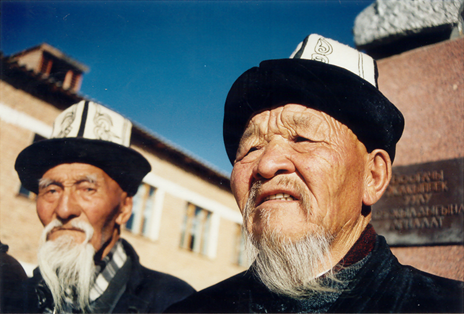
In the wake of the ethnomusicological research of Béla Bartók and A. A. Saygun
It is widely known that Saygun escorted Bartók during his Anatolian research trip. We know their correspondence, and we know too that instead of America Bartók would have chosen Turkey to migrate to. He asked for Ahmet Adnan's help, but as Saygun (1976: 416) wrote "... Bartók was undesirable in Ankara. On the other hand, the fact that Bartók's proposal was being made through me was enough to aggravate the situation since I was, myself, undesirable in Ankara too."
Bartók's Anatolian research was published in 1978 in America, and the Turkish version of this book was published in 1991 in Turkey. The work came out in Hungary in 1978 with Saygun's valuable complementary analysis and comments in English. I published the book in Hungarian in Budapest, 2019.
Hungarian-Turkish comparative folk music research had begun early. Unfortunately, after 1936 it stopped for a longer period, though it is imperative for every nation to know the music of their neighbors and cultural and linguistical relatives to explore what is particular and what is common in their folk music. It holds true in general as well, that the comparative examination is more informative to studying the music of people separately. Characteristic is, that besides collecting and analyzing Hungarian folk music Bartók worked on Rumanian, Slovakian, Turkish and even Arabic folk music as well.
As a scholar Saygun approached folk music research from two aspects; in one hand he collected and analyzed music on smaller areas (e.g., the Black Sea), on the other hand he tried at summing up the musical world of large areas. We might disagree with some of his thoughts concerning the spread of the pentatonic music,[1] his universal approach was exemplary in his time.
Though the newest, primarily American trends of ethnomusicology push the analytical research towards the social/ cultural anthropology not using musical analysis and even transcriptions anymore, the analytical and comparative musicology is on the agenda in our day. One of the main reasons for this is that besides well explored folk music repertoires there are huge unbroken musical lands as well. In the case of Turkic people, we can read valuable books on the Tatar, Chuvash, Kazakh etc. folk music while we know much less about Karachay or Kyrgyz folk songs, and a comprehensive book on Anatolian folk music has not been written yet either.
Maybe one of the most appropriate ways to remember to exceptional people is to continue their projects. Let us think for a moment what Saygun and Bartók would do if they could participate in a folk music research group. First, they would surely continue collecting, archiving, transcribing, and analyzing Anatolian folk songs. They also would probably expand the field of the comparative musical research to other Turkic people, and step by step they would involve their songs into the research.
I have been following these principles for twenty years now. In 1987 I started the comparative work where Bartók finished his - in the vicinity of Adana, and later I gradually extended the area beyond Turkish territory.
I would like to show an example to this comparative research. First, I choose a melody type of a Bektashi community living in Thrace. Since 1999, my wife and I have collected more than 1100 melodies in 24 villages from 150 Turkish women and men of the Bektashi faith, whose grandparents migrated from the Balkans to the European part of Turkey. By the end of the research series, it seemed so that we had reached our goal, and recorded most of their religious and secular songs. [2] Though we examined the social and religious life of the Bektashi community as well, this time I concentrate on their music only.
First let us shortly overview the main musical forms of this community. Their mound-shape or descending sections give most of these songs a common stylistic base. What connect them together even tighter is the conjunct melodic movement, that is inside the sections the melody proceeds with prime or second steps, and the compass of the neighboring sections overlaps each other.
Based on these common features I classified most of the songs according to a single principle: the form.[3] - We may analyze the hymns and the folksongs together, because most of the religious songs have folksong parallels. The only difference is that hymns are to be found among the more developed forms while the simplest melodies are almost exclusively folksongs. [4]
Every section of the simplest melodies descends to the final tone.[5] A little more complex are the periods: here only the end of their short sections is different (ex.1c-d).[6] Several melodies are built up of two, basically different short sections, here the first phrases are usually mound shaped or descending while the second ones descend from E to A. (Example 13e-f).[7]
a-b) Major and minor melodies descending to A in every section ,
c-d) melodies with AkA form , e-f) a few two sectioned melodies
The other half of the melodies has a quadripartite, descending structure. [8] According to the character of the descent they can be arranged into three groups. The melodies in the first group have two long sections with iiii / i i / iiii / i rhythm scheme. The higher tones at the middle and at the end of the beginning of the melodies give the first half a stagnant, sometimes even ascending character (Example 14a).
The second group contains the most balanced forms; here a higher moving section is followed by two sections in medium register and the melodies close with a section descending from E to the A final tone.[9] The rhythm of the sections can be trace back to the iiii / iiii rhythmic scheme (Example 14b). The distinctive feature of the third group is, that their sections follow each other in descending second sequences (Example 14c). [10]
a) 1st group, b) 2nd group, c) 3rd group
Let us have a closer look at the second group. The greatest differences between its melodies can be seen at the beginning. Many melodies move on the C-D-E trichord till the end (Example 15a), while other melodies use higher tones in the first or the second sections (Example 15c). There are similar melodies beginning higher as well (Example 15d). Most of these melodies move on Minor scales, but there are some moving on Major-like scales as well. Example 15e.f.g are the first three melodies of Class A. I. in Bartók (1924) written under each other in a simplified form.
e-g) the 1-3 melodies of Class A.I. in Bartók (1924) written under each other in a simplified form
As we see on ex.3e-g, the first three melodies from the first melody class of Bartók's The Hungarian Folksong book are very similar to the melodies we are discussing, and they represent old and important layers of the Hungarian folksongs.
Whether similar melodies can be found in the music of other Turkic peoples, and how broad a musical layer represents them? In many parts of Anatolia, we can find this melody types, and almost every representative of the Hungarian style has Anatolian parallels.[11] It was not an accident then that relatively many tunes of this type were found by Bartók during his collection of 1936. Let us see one of these tunes and its Hungarian parallel (Example 16).
During my Azeri expeditions, I did not come across Azeri tunes of this character, but some similar species appear sporadically in more or less reliable Azeri publications (Example 17a). However, the predominant Azeri musical style contains mainly trichordal-tetrachordal tunes of two short sections.
Among the Aday Kazaks living in Mangishlak on the eastern shore of the Caspian Sea this type of melodies is popular. Here this musical form is represented more massively than among the Azeri people but less than in Anatolia or Hungary (Example 17b).
My Kyrgyz collection and other Kyrgyz publications tend to prove that in Kyrgyz folk music (predominantly of Major character) these tunes do not play any significant role. One of the few examples is shown in Example 17c.
There is a group of tunes in Karachay-Balkar folk music that displays similarities with certain simple type of these tunes (Example 17d). Ex.5d shows a Karachay tune that resembles the simplest tunes of the examined musical style in embryonic form.
By contrast, lots of similar musical solutions can be found in the folk music of the Avars living in northern Azerbaijan and Dagestan. Typically enough, one-sixth of the Avar tunes I recorded are more or less similar to these melodies (Example 17e). It is, however, noteworthy that the Avar (and the above mentioned) tunes display only similarities, and never identity, with the Hungarian and Anatolian melodies, e.g., the four-sectioned structure is very rare here.
In Tuvanian folk music only a few tunes show some similarities to the melodies examined now. One of them is shown in Example 17f. The pentatonic folk music of the Mongolians, the Mongolian Kazaks, the Tatars, [12] Bashkirs, Chuvashs and Cheremis is devoid of this musical formula.
We examined Rumanian, Slovakian, Finnish, Appalachian, German, French, Spanish, Sicilian and Morvinian musical collections and we found several similar melodies in the Spanish, Sicilian, Morvinian and Romanian material.[13]
To sum up: this melody type, or at least some types of it, occurs in the folk music of many different people. The cited analogies are sporadic and discernible in few peoples' folk music, except for Hebrew, Gregorian and Romanian tunes. It is also known that these Hungarian tunes can only be found in Transylvania and its border areas. It may perhaps be tied to the Seklers (Hungarian people with strong traces of Turkic origin) and it has never been prevalent throughout the Hungarian speaking territory.
The recently found examples have stretched the area of this melody type towards the Balkans, Asia Minor, and the Caucasus, though its weight in the folk music of different peoples, and its form may vary considerably. In the folk music of Central Asia characterized by pentatonic scales one can hardly find similar strata, as they tend to be predominated by motivic and disjunctive melody construction. By contrast, this kind of melodies constitutes a significant stratum in the music of the Caucasian Avars, and one finds sporadic specimens of the style in Azeri folk music. In Anatolia and Thrace, on the other side, there are lots of similar tunes, and among the Aday Kazaks on the eastern shore of the Caspian they also constitute an important layer.
According to the latest computer examinations similar forms can be found in Spanish, Sicilian, Moravian, and Rumanian folk music. In the Slovakian music we find similar melodies too, only moving on Major scale. The research should be extended to other folk music as well.
As we know, the cooperation of Béla Bartók and Ahmet Adnan Saygun had a good outcome, but the Anatolian folk music research has not come to an end, there remained lots of things to do. That is why I am doing continuous efforts to create a Hungarian-Turkish research group, with the first mission to make a comprehensive classification of Anatolian folk music. I hope that booth Bartók and Saygun would support the idea.
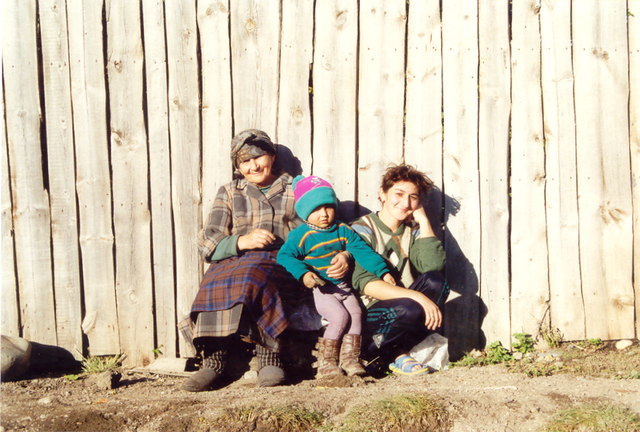
Dakota Folk Songs and their Inner-Asian Connection
Are there any relationships between the folk music of American Indians tribes and the folk music of Turkic, Mongolian and Hungarian people? Or is this question nonsense? Not at all because the ancestors of the American Indians had come into the Western hemisphere form Asia in a series of migrations; and from Alaska they spread east and south.[14]
And another question: where a Hungarian ethnomusicologist takes the liberty from to say something on the folk music of American Indians, especially as according to Nettl (1954: VI): “During the first half of the twentieth century, aboriginal North America has become the continent of primitive cultures whose music has been the most extensively studied and is best known.”[15]
Indeed, American scholars and amateurs made enormous research among Native Americans; as the joke says the smallest Indian family had five members: father, mother, two children and an anthropologist. Is there any need then for a Hungarian scholar to gnaw off gnawed bones? The answer to this question is positive as well. Hungarian and American scholars use different methods, and a Hungarian comparative musical analysis might bring forth important results in ethnomusicology and may even give new results on the origin of the Indians. The thorough knowledge of the Turkic, Mongolian and Hungarian folk music is not a disadvantage as well.
Hungarian ethnomusicologists searching for the eastern relations of the Hungarian music made significant efforts exploring the folk music of the Volga-Kama region and that of Turkey.[16] Later the area of the research was extended to Azeri, Kazakh, Kyrgyz, Karachay, Mongolian and other people as well.[17]
It was known that similarly to many Turkic and Mongolian people, the melodies of many Native American people move on pentatonic scales. This fact motivated some Hungarian researchers to collect among Native Americans, though this research were carried out only in South America and were not too extensive as well (Halmos 1979 and Ördög 1997).
In 2004-2005 as a Fulbright scholar at the Department for Ethnomusicology of UCLA I had the opportunity to study the folk music of two Native American tribes, the Dakota, and the Navajo. I started my work with transcribing and analyzing many hundreds of Dakota songs collected by Willard Rhodes in 1939-1941 in Pine Ridge, Montana. This material is in the Archives of Ethnomusicology, UCLA.
Now I was ready to do field work. My university colleagues warned me not to visit Indians; You will not be able to collect melodies from them - they said. It was clear that white men do not have a good reputation among Native Americans. Who loves those who decimated his people, confiscated his land, prohibited his culture, and finally pushed him into reservations? However, I had a great advantage: I am not American, Spanish, English or French. Being the son of a smaller nation, it is easier to play ball with another small and oppressed people.
I had another difficulty as well: songs have special importance for the Indians, they are often personal or tribal property and Indians do not give them out easily. One may not use someone else’s songs without first having been given those songs, or at least the right to use them. This is accomplished usually by giving a gift to the song’s owner. Today, as it was in the past, many Indian song makers say that the inspiration for their songs is acquired through dreams or visions. It is said that often a song maker will hear a song in a dream and will wake up singing it (Bierhorst 1979: 5). Some songs and ceremonies, such as Navajo blessing chants, must be performed precisely. Any deviation or errors in the words or music negate the power of the song and the whole process must be either abandoned or begun again from the beginning. So, a song accompanying a religious ceremony not only sets the mood for the worshippers but carries power.
Despite all of these difficulties I carried out nice fieldworks among Navajo (300 songs) and Dakota Indians (250 songs) as well. Navajos are today the most populous East American Indian tribe; they speak their language and keep their culture alive to a large extent. In 2004-2005 we started a research series among them with Jerry L. Jaccard, the Vice-President International Kodály Society who used to be a teacher in the Four Corner Navajo reservation for a longer period.
The reason of choosing the Dakotas was different. Most ethnomusicologists accept the important place of northern Indian music among the American Indian styles, and this music plays an outstanding role in contemporary powwows as well. Here too I needed someone to introduce me into a Dakota community. A Dakota man, Dwight Youpee who worked at the Department for American Indian Studies (UCLA) received me into his friendship and recommended me to his acquaintance in the Fort Peck Community College. In november 2004 I flew from Los Angles to Salt Lake City with a giant airplane, from there to the north, to Billings with a much smaller one, and from there with a tiny aircraft with ten seats to Wolf Point, where my helper Adrian Spotted Bird was waiting me.
These wonderful people put up me, sung their songs, introduced the musical repertoire of their ceremonies, they even invited me to sing with them in the sweat lodge and smoke the pipe of peace. The time I spent among them will remain one of the most remarkable memories of my staying in America. Though there were serious alcohol and drug problems in the reservation, I was bewitched by the philosophical and emotional greatness of the Indian intelligentsia.
Let now me say a few words on the music of the North American Indians. The common origin of the Amerindians explains the physical characteristics that Amerindians have in common, while the several waves of migration are supposed to account for the many native linguistic family. Charles and Florence Voegelin (1966) keep in evidence 221 different languages only in North America.
There are lots of common characteristics of the music of the different North American Indian tribes. Common is the descending melodic line, the pentatonic scales and frequent is the vocal tension. At the same time there is a great diversity of musical styles. These can generally be grouped into divisions which follow roughly the major cultural areas. Naturally, where cultural areas meet and overlap, there is a sharing of characteristics. However, some areas developed independently for several centuries (e.g., Southwest and California or the Great Basin).[18]
There are several publications on the music of the Dakota people (Reference). From these I mention two, containing many transcriptions and some analysis as well. Frances Densmore (1918) did a complete analysis of the Teton Dakota of the Eastern part of the state of South Dakota and Juries (1965) investigated the music of the Dakota Indians of the Rosebud Reservation.
Analyzing the Dakota songs, I used the songs in the Rhodes collection and those collected by myself. First let us have a glance to the scales, the range, the rhythm, and the melodic movements. For lack of space in this paper I discuss only Dakota melodies moving on the A’-(G)-E-D-C-A la penta- or tetratonic scale.
Scales and range
As we have already mentioned the interest of the Hungarian scholars was aroused by the pentatonic character of the American Indian music. However, in the Rhodes collection a remarkable phenomenon was to be observed. In contrast to the A-pentatonic scale in many Asian melodies most of the Dakota songs in the Rhodes collection are moving on the (A’)-E-D-C-A tetratonic scale.[19] However, the intonation of the tones in the scales might be strange to an ear being accustomed to European music (though not to the connoisseurs of different Inner Asian musics). As John Bierhorst, a writer and compiler of information about Indian culture explains: “just as in the music of the birds, Indian music does not always keep to the fixed tones that can be played on the piano. Some notes are quarter tones - in between the half tones on the piano. Here and there a note may be made up of several tones, like a syllable of ordinary speech.” The Northern Plain singers usually sing with a certain amount of tension in the throat and vocal cords.
Rhythm and meter
In contract to the most characteristic Asian musical styles many Dakota (and generally North American Indian) songs do not fit any standard 3/4- or 4/4-time signatures; different time signature must be used for nearly every measure. “Putting these songs into notation is like putting them into a straitjacket.” (Bierhorst 1979: 6). At the same time songs connected with dances tend to have more of what might be called body rhythm, that regular foot-tapping kind of beat Bierhorst (1979: 6). Singers do not always mark the beginning or the end of musical phrases with accents, long notes or pauses. Having equal intensity, the drumbeats do not help to define the structure of the songs either. 6/8 (3+3) and its extension to 9/8 (3+3+3) are common time signatures but here too we often are in trouble where to put the bar lines. [20] Similarly, the rhythmic formulas in different sections of Dakota songs might differ considerably. There are also only a few isometric and/or isorhythmic Dakota songs.
The texts are usually not strophic; meaningful words alternate vocables, and many texts contain exclusively vocables without exact meaning but sung the same way every time. Most probably American Indians do not feel the necessity to use many words because a few words can satisfactorily express a widely known idea or event. This phenomenon above is frequent in Inner Mongolian folk songs too, but rare in the folk music of Turkic or Hungarian peoples.
A remarkable phenomenon is that drummer and singer start out and end together, but the rhythm of the vocal and the drum may shift from each other throughout the song. The vocal part sings ahead of the drumbeats for a while, as they say at the powwows, they ’sing off the beat’. Similar but not identical kind of rhythmic shift can also be seen in various forms in the folk music of different peoples. As an example, the fiddler of a Hungarian gypsy band often plays an eights value ahead of the band but not later that the end of each song it rejoins the accompaniment. Though here we cannot imagine any genetic relations, the examination of this rhythmic phenomenon in different musical words would be important.
In Dakota folk music, the drum often stresses the weak parts of the bars. This phenomenon is well known in other part of the world too, though not in Inner Asia. A more specific Amerindian phenomenon is that the drum beats triplets not only in 6/8 but also in 2/4-time signature.[21] As if Dakota people sometimes would feel triple pulsation in even-numbered bars as well. I observer this beautiful and original phenomenon in several the melodies of the Rhodes collection, but not in the newer recordings.
Melodic line
The melodic movements of the Dakota songs obey some general rules. The descending tendency and the tetratonic scale limit the number of possible steps. Melodies often begin on the tonic then jump up to the fifth or even to the octave. Inside sections typical melodic movements are recitation on a tone or one or two steps in the same direction followed by a step back. In contrast with this Middle-Asian pentatonic melodies are characterized by more vehement melodic movements. At the beginning and at the end of the Dakota melodies we often hear sound-repeating initial and closing formulas. Repetitions of melodic sections are usually very accurate, except the beginning of the melody which tends to be changed or even omitted.
Let me now introduce now the central melodies which characterize the whole material best. As criteria for the classification, I choose the cadences (last note of the melodic sections) and the range of the melodies.
A. Melodies with narrow ranges
There are melodies moving on 3 or 4 tones: (E)-D-C-A. These melodies may differ from each other considerably and probably represent different old layers of the Dakota folk music. Simplest is a story song reciting on C then descending to A, and some lullabies moving up and down on the D-C-A triton sometimes reaching E as well. Most of these basic songs built up of two short, repeated sections with C or D cadences have a descending character (Example 18).
B. The central musical style (descending an octave)
The melodies of the most important central musical style are characterized by different realizations of an octave descent.
Steady descent in one section (and an additional descent)
Lots of Dakota melodies descend an octave from A’ to A without an interruption by long notes, repeated notes or longer breaks. The second half of the melody usually shows a descent from D or E (Example 19).
Descent with inner cadence – two-section melodies
There are melodies with two different sections, where the first section descends from A’ to a middle sustained or repeated cadence note (C, D or E). The second section descends from A’ or E to the tonic. Example 20 is seemingly three-sectioned, but the third section only reassures the closing formula at the end of the second section.
Three-section melodies
Often accurate E and C (or E and D) repeated cadence notes divide the octave-descent into three balanced parts (Example 21).
Four-section Dakota and Hungarian melodies
In Dakota folk music the four-section form is relatively rare, and the genre of these melodies is usually ‘love song’. They have descending character too, the descent beginning from the octave. According to the cadences there are five different groups of these songs.[22] The first sections usually move in the upper half of the octave, the middle sections in the middle register and the last sections in the lower register of the octave. In the next table we compare some characteristics of the Dakota and Hungarian songs.[23]
|
|
Dakota |
Hungarian |
|
tone set |
tetratonic |
pentatonic |
|
sections |
descending |
descending |
|
motifs |
A-A’-E-D, E-A’-E-D or A-D-C-A, E-D-C-A, less frequently A’-D-C |
A’-G’-A’-E, A’-G’-E-A’, G’-A’-E-C, D-C-D-G, C-D-C-G (G playing a more important role) |
Now, let us see two representatives of the four-sectioned Dakota melodies with their Hungarian parallels (Example 22).
a) Dakota melody with E-C-D cadences and a Hungarian parallel,
b) Dakota melody with E-D-C cadences and a Hungarian parallel
Fifth-shifting Dakota, Hungarian and Mongolian melodies
The fourth type of the four-sectioned songs has a special importance as they have a disjunctive structure: the first part moving in the upper half of the octave with a cadence on E, and the second half moves in the lower part. In this way, they show some similarities to some pentatonic fifth-shifting Mongolian, Tatar, Chuvash, and Hungarian melody types. Within the scope of the present study, we cannot compare the Dakota, Hungarian and Mongolian fifth-shifting styles in details, only a few examples are provided here (Example 23). [24]
C. Melody types with larger range
There are a limited number of Dakota melodies with a range wider than an octave. [25] As an example I show a four-sectioned melody with A’-E-C-A cadences (Example 24).
Conclusions
Are there similar musical layers in Dakota, Hungarian and Mongolian folk music? These songs move on similar scales with a descending tendency, what is more there are four-section and even fifth-shifting melody parallels as well.[26] However, in many cases rhythm, melodic and motif structure show considerably different features. One of the most important differences is that while the sections of Dakota songs show continuously descending character,[27] Inner Asian pentatonic songs are often built up from motifs.
Are these differences the consequence of the separation of a one-time common musical culture or are they an accidental similarity between two musical cultures that have never had any contact with each other? The science of ethnomusicology is not yet able to answer this question with certainty. However, musical analysis above allows the possibility for the Asian origin of certain (four-sectioned) Dakota musical layers. Therefore, we may consider these melodies as slightly different realizations of a common musical base.
Though most A-pentatonic Dakota melodies belong to the same musical style, Dakota music is a significant creation characterized by homogeneous and clear forms, just as all great musical styles.[28]
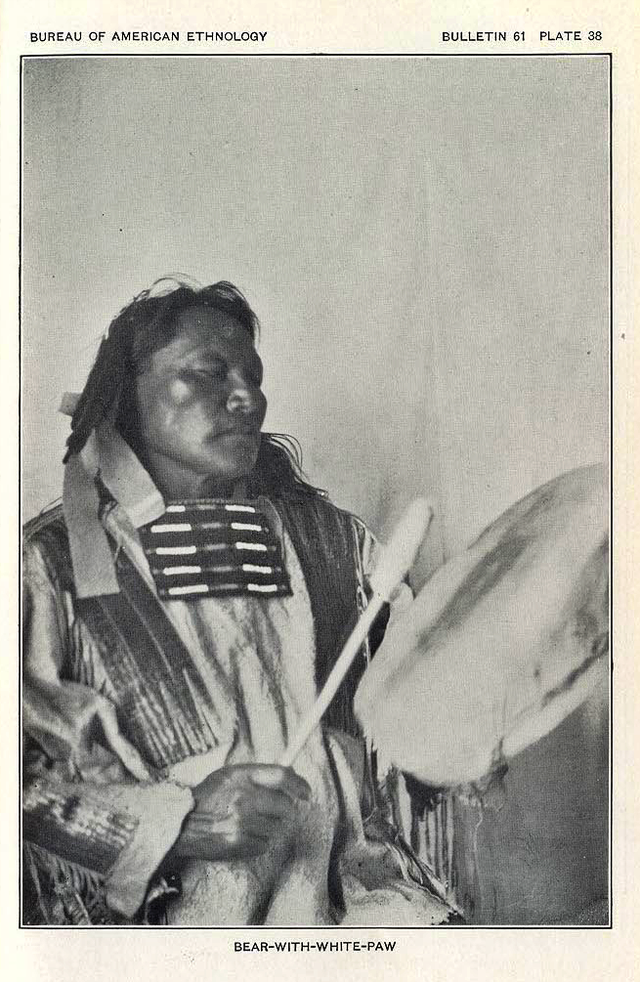
Ancient Hungarian musical styles and their connection to the folksongs of Turkic people
Laments
In recent decades, the international connections of the Hungarian lament style were summed up by Lajos Vargyas (2002: 239-262) and László Dobszay (1983: 49-95). In search of tunes resembling the Hungarian laments they reviewed the accessible material of European folk music, and Dobszay also surveyed the Gregorian stock. Their findings can be summarized as follows: Music of this kind can be found as a more complex style in Romanian, Slovakian, Bulgarian and Spanish music. In Romanian music there are laments of two re-do cadences and others with VII main cadence of Dorian-Phrygian character in addition to the single-cadence fa-mi-re-do laments. The Slovakian small form found along the Hungarian borders is certainly a borrowing from the Hungarian material. The Bulgarians usually have strophic tunes of shorter lines. Tunes resembling the small form of Hungarian laments can sporadically be found among Serbian and Macedonian, as well as Sicilian, French, and German tunes. That said, some tones of the plainchant are closer to the Hungarian lament style than any of the above tune groups (Dobszay 1983: 61-75).
Pertinent tunes crop up in Vogul, Ostyak, Finnish, Estonian, some Turkic music around the Caucasus, but the surveyed collections are by far not complete, and relevant publications are wholly missing for the music of certain ethnicities.[29]
László Vikár’s and Gábor Bereczki’s field research in the Volga region also has relevance to laments.
The tone set of Mordvin laments is usually a mi-re-do or (re)-do-ti-la tri-/tetrachord but built into a single-cadence twin-bar structure.[30]
The tunes of minority Votyaks mainly have a single cadence and are not descending but are built of do-re-mi-(sol’-mi)-re-do hills and mi-re-do descents; at the end of the first line of several tunes a do-re-mi rise can be heard. They are therefore far from being direct relatives of Hungarian laments, while the hill-shaped line is very similar to a basic form of Kyrgyz laments.
The core of the very simple tunes of Chuvash people living in the southwest of Tatarstan is (sol’)-fa-mi-do (or re’-do-ti-sol) with a wavering 2nd degree. The bride’s laments are typically convex with do-mi-fa-(sol’-la’)-mi-do arches, which reminds one again of a basic form of the Kyrgyz lament (Vikár-Bereczki 1979: 33).
In some tunes of the Tatars and Bashkirs the (sol’-)-mi-re-do tetra or triton may occur, but in Hungarian music this is built into a varied melodic realm of pentatonic motifs (Vikár-Bereczki 1979). Apparently, the lament is no longer alive among them or among the Cheremis people.
In sum it can be concluded that in the Volga-Kama region musical forms similar to the Hungarian lament style can only be found among the Ob-Ugrians, although this similarity is not confirmed by several researchers.[31] The Ob-Ugrian tunes are not lamenting but heroic songs.[32]
To these earlier data I have added the conclusions of my Anatolian, Azeri, Kyrgyz, Kazakh and Karachay-Balkar lament collections.
A large amount of Anatolian data prove that in Anatolia the one- or two-cadence forms with the pentatonic (la’)-sol’-mi-re-do and diatonic (la’)-sol’-fa-mi-re-do tone sets are prevalent both with an additional descent to la or without; they are arranged into unfixed forms and used in lament, bride’s farewell, lullaby, etc. i.e. in authentic recitative genres (Example 25a, Sipos 1994a: 46-49, Sipos 2000a: 57-96, Sipos 2002a: 50-83).
During my Azeri field work I found large numbers of one- and two-cadence laments (Example 25b, Sipos 2004a: No. 29, 35). It is noteworthy that this tune style was practically the only one in which considerable musical similarity could be discovered between Azeri and Anatolian Turkic folk music, though the two ethnic groups speak very close Turkic dialects. In the music of these groups’ formations resembling the large form of the Hungarian lament are only sporadic.
The laments of the Kazakhs of Mangishlak on the eastern shore of the Caspian Sea move on the same Phrygian chord – following a different musical logic, though – than the most typical tune groups of the Azeris, sometimes sinking a note lower additionally (Example 25c).[33] I only found a single Mangishlak lament whose tonality and form resembled the small form of the Turkish and Hungarian laments.
The folk music of Mongolian Kazakhs is basically do-pentatonic. This scale is used by the match-making songs and the actual folksongs forming hill-shaped or undulating melody lines and the laments also descend on this scale (Example 25d). Most frequent is the single-core form always sinking to do, but there are considerable tunes cadencing on re or mi, but they are not in the genre of laments.[34] It also occurs that there is an additional descent without words attached to the end of the melody.
The two major groups of Kyrgyz laments are clearly outlined. One is a major tetrachord hill-shape extending downward with a fourth leap, and the minor version of this lament is also found parallel to it (Example 25e). The two-cadence small form can be found in the Kyrgyz material as lament, bride’s farewell, and a genre similar to “plaintive” songs (Example 25f).
In the studied Tuvan folk material, there is a single melody that displays similar motion to the two-cadence laments, which is too meagre to draw serious conclusions from (TUI: No 27).
This kind of laments does not occur in the perfectly pentatonic music of the Mongols. Rarely, however, one may come across Mongolian tunes with re- and do-cadences moving on a major hexachord, but their character is different.[35]
The simplest Karachay-Balkar lament tunes and their relatives have each line descend to do, but there are also plaintive tunes similar to laments with two cadences (Example 25g). I found Karachay laments in which the lines undulating to do are terminated with a line descending to sol. (Example 25h). The type of the lament that extends downward (fa-mi-re-do› ti-sol) also has a variant here, which is shown with a Hungarian analogy below (Example 26).[36] What makes all this particularly noteworthy is the fact that in Karachay folk music there are hardly any pentatonic tunes.[37] Among the Karachays of Turkey one also finds tunes resembling the Hungarian major hexachord laments with two cadences, but their genres are different.[38]
Let me add a few facts. In Anatolia one finds minor laments as well, and moreover, the Hungarian Phrygian laments repeatedly descending on a scale with a minor third have quite a lot of corresponding Anatolian tunes (Sipos 1995: 87-88; 2002: 271-274). Strophic forms derived from two-cadence laments can also be found in Anatolia and the large form that evolved from the small form also crops up, though sporadically (Sipos 2002: 75-79).
However, as seen above, different groups molded tunes and laments of different character from the potential of the major-pentachord. In addition to the descending line, popular is the hill-shaped do-re-mi-fa-sol’-fa-mi-re-do lament core, sometimes with an additional jump down to sol at the end of the lines (Votyak, Cheremis, Kyrgyz).
Lajos Vargyas argues rather resolutely by the Ugrian-age origin of the lament. Based on eastern data László Dobszay also concludes that they allow for retracing the root of the lament to the Ugrian age, but he urges for further research.
More recent data do not confirm that this form was a general style occurring everywhere, but it crops up in the music of many peoples with widely different ethnogenesis. At any rate, it is certain that there is a multitude of examples in the music of several Turkic peoples, in the genre of the lament and in many cases in such great numbers that they constitute a style.
The psalmodic style and its connections in Turkic music
Among the old tunes of Hungarian folk music there are descending tunes and others that basically recite the do-re-mi core. Bartók did not separate them in his system of folk music, e.g. in his book The Hungarian Folksong (Bartók 1924: 1-3, BÖI: 181) the first three tunes of Class A.I are dodecasyllabic with 5(b3)b3 cadences, but while the first tune begins with do-re-mi and already reaches sol’ in the first line, the second remains in the do-re-mi band almost throughout, and the third recites high, on degrees 7-8.
Unlike the Bartók System, Kodály treats the reciting tunes beginning with do-re-mi separately and the Hungarian research in general divides the recitative tunes into two groups: the ‘psalmodic’ tunes moving on the do-re-mi trichord and those of an octave range.[39]
Citing the tune of Szivárvány havasán [On the alp of the rainbow] Kodály (1937-1976: 36) writes the following: “This tune, at least its first half, has innumerable variants among the Mordvin, Zuryen, Votyak tunes collected by Lach. Yet, no Finno-Ugrian or Turkic archetype can be discerned in it: more rather, it implies some more universal, supranational, primeval recitative formula, for the above-mentioned groups could hardly borrow it from the liturgical psalms of the Christian or Jewish churches where it still has a great role.”
Bence Szabolcsi (1936: 243) lists the do-re-mi tunes as forms also related to Near Asian, Jewish liturgical music, while Benjamin Rajeczky (1969: 58) cites medieval German examples belonging to this musical sphere.
In their study of 1977 László Dobszay and Janka Szendrei extended this tune type into a style. The extension took place in two directions. On the one hand, they united in one style the tunes moving on do-re-mi and some other tunes which contain higher notes as well, yet their core is clearly do-re-mi and they can be differentiated from fifth-shifting tunes by their conjunct construction,[40]and on the other hand, they pointed out the strophic variants of this basically recitative style.
Let us see what role the style may play in the folk music of Turkic groups.
In Anatolian folk music there are large amounts of similar tunes to such an extent that both the low-register and high-moving Hungarian types could be paired with Turkish analogies.[41] What is more, the pertinent tunes are generally prevalent and popular in Turkey.[42]
In my Azeri collection of some 700 tunes practically no psalmodic tunes can be found, but they sporadically occur in more or less reliable publications.
Among the Aday Kazakhs on the eastern shore of the Caspian Sea psalmodic tunes are popular. This musical style is represented here more than among Azeris but less than in Anatolian or Hungarian folk music.[43]
My Kyrgyz collections and other publications seem to suggest that this style does not play a decisive role in the overwhelmingly major character Kyrgyz music. E.g., a Kyrgyz tune that is relatively close to the psalmodic style, but its first line rising from deeper, the f2 playing a central role in line 3 and other features keep it rather away from it.
There is also a smaller tune group in Karachay-Balkar folk music which display some similarity with certain psalmodic tunes (example 348d), yet they did not evolve into a style here or among the Tatars of the Volga region. Two Tatar tunes of this style have been found, but they appear exceptional among the 1200 studied Tatar songs (Nigmedzjanov 1970, 1976, 1983).
Musical solutions typical of the style are massively represented in the music of Avars living in Azerbaijan and Dagestan. One-sixth (!) of the Avar tunes I recorded show similarity with the Hungarian psalmodic tunes.[44]
Going farther eastward, in the pentatonic music of the Mongolian Kazakhs and Mongols this musical form is missing, and only a few Tuvan folk tunes display some psalmodic features.
More recent examinations thus have found the psalmodic style (or some of its types) in the music of more ethnic groups, yet it is not found everywhere, and its weight is also greatly different in individual musical repertoires. It is also important that in Hungarian-speaking areas it is only present in Transylvania and the bordering areas, which may suggest that it may belong to the Secler people who are presumed to be of Turkic origin, though this has not been verified yet.
At any rate, in Thrace and Anatolia such tunes crop up in large numbers and form an important stratum in Kazakh folk music along the eastern side of the Caspian Sea. This is an important layer in the music of the Avars speaking a paleo-Caucasian language and sporadically one can hear psalmodic tunes among the Azeris. At the same time, more to the east in Central Asia and in folk music that are typically pentatonic hardly any similar tune can be heard; in this region the predominant melodic construction is the disjunct structure built of parallel lines.
Songs of Hungarian children’s games and their connections with Turkic music
In Kodály’s view (1937-76: 54) the mi-re-do trichord motif rotating around its middle note “is the possession of a far larger human community.” It is no wonder then that “the entire music of the paleo-Asian Orok people consists exclusively of it” (Vargyas 2002: 19), but there are German ditties of this type, and one may adduce similar Turkmen, Iraqi, Dobrudja Tatar and other tunes (Belaev 1975: 136, Kapronyi 1981).
It is thought-provoking that the Hungarian mi-re-do-re tunes of customs are all related to the magic of plenty and to illnesses caused by the evil eye.[45] Since now we know Asian children’s songs the great majority of which move around the mi-re-do core, we need not presume that our ancestors leant the Hungarian children’s games and their tunes only in the Carpathian Basin.[46]
Tunes moving on mi-re-do and finally closing on re are just as frequent among Turkish and other simple Turkic children’s songs as among Hungarian ditties.[47] In Azeri folk music similar musical forms almost only appear among instrumental tunes. Such are the tunes of Quran recitation among Azeris, Kazakhs and Karachay-Balkars.
The Ozay and Gollu tunes of the Karachay-Balkars’ ancient religion ends on re and move deeper,[48] while it applies to the pentatonic Turkic-Mongolian folk music repertoires in general that although the mi-re-do and even the la’-so’-mi-re-do core is strongly represented in them, the mi-re-do core rotating around its middle note is missing.[49]
Above, a brief survey of the Turkic analogies of the major Hungarian folk music styles have been presented, without explicating a crucial aspect: however similar these styles may be, they are not identical: in addition to smaller or greater similarities they display considerable differences and varying inner proportions. The examination of the differing musical logic beneath musical phenomena showing similar features will remain an important research theme of the future holding particularly intriguing discoveries in store especially for Turkic groups who speak related languages but their ethnogenesis was different.
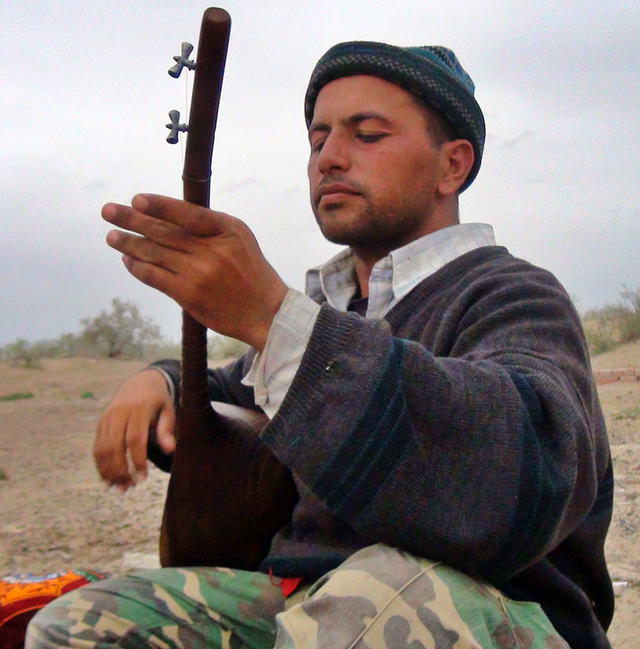
An Inner Mongolian pentatonic fifth-shifting style and its relevance to Hungarian and Volga-Region folk music
Several tunes in the old pentatonic layer of Hungarian folk music descend from the octave. In some of these, descent is free, while in many others more or less regular motion can be observed. Fine examples of regular forms are the fifth-shifting tunes the second halves of which are four notes lower than the first. In this paper, I am going to outline the spread of pentatonic fifth-shifting tunes in Asia and the interrelations of major fifth-shifting styles.
The first to describe the Hungarian fifth-shifting tunes was Béla Bartók.[50] Zoltán Kodály gave a detailed analysis of the phenomenon of fifth transposition, adding Cheremis and Chuvash analogies to the Hungarian tunes.[51] The investigations of László Vikár and Gábor Bereczki in the Volga-Kama region proved that the fifth transposition only prevailed on both sides of the Cheremis/Chuvash border, within a strip of some 100 km in width, gradually disappearing with the growing distance.[52] Extending this finding, Lajos Vargyas noted that this style was missing from the folk music of Mordvins, Votyaks, Bashkirs as well as the Kazan and Miser Tatars.[53]
Bence Szabolcsi added analogous Kalmuck, Baikal Mongol and Chinese melodies to illustrate fifth transposition[54] and he tied the Hungarian style to "a peculiar stylistic variant of pentatony which predominated all great cultures everywhere: that of Inner Asia." He also spoke about more general melodic parallels between the pentatonic layer of Hungarian folk music and the folk music of a vast area connecting many peoples and cultures.
After this brief survey, let us summarize the findings. In West Europe there are only traces of sporadically occurring non-pentatonic fifth transposition, while among our neighbors (Moravians, Slovaks) fifth transposition is mostly a secondary development upon Hungarian influence. In Hungarian areas there are numerically few but widespread tunes representing fifth shifting. Father away, in the Volga region, on the Cheremis/Chuvash border there is a flourishing fifth shifting style, whereas it is practically unknown in adjacent areas to it. One can find individual tunes in Peru, for example, that almost perfectly coincide with some Hungarian fifth-shifting tunes.[55] In addition, as has been seen, sporadic fifth transposition can be come across in Mongolia and China as well.[56]
Fifth transposition among Turkic peoples
Let us first see if there are pentatonic fifth shifting tunes in the folk music of some Turkic groups.[57]
Only traces of the pentatonic scale can be discovered in Anatolian Turkish folk music, and only a few tunes of the quintal shift structure were spotted in the whole studied stock.[58] They, too, were mainly two-line tunes with natural correlations between the first part descending to D and the second descending to G, including, accidentally, partial fifth shifting as well (Example 28a).
Not even a trace of the quintal shift structure can be discovered in the folk music of Azeri Turks which comprises narrow-range diatonic tunes in the first place.[59] That is no surprise, as in Azerbaijan an Iranian population became gradually Turkicized.
The same applies to the folk music of the Mangishlak Kazaks on the other side of the Caspian Sea.[60] Neither pentatony, nor the quintal shift could be discovered in a southwestern Kazak area where narrow-compass diatonic tunes are predominant.
The music of the Karachay and Balkar people on the northern side of the Caucasus already includes fifth-shifting tunes.[61] However, because of their melody contour, diatonic scale, 3/4 meter, singing in third and vocal harmonic accompaniment these tunes are fundamentally different from the quintal shift structures in Hungarian and Volga-region music (Example 28b).
In the stock of Tatar and Bashkir pentatonic melodies parallel motion, repeating some melody sections a fourth or fifth lower is frequent.[62] The music of these peoples includes the potential of the quintal shift, yet the fifth-shifting style has not developed here. In our example, the second half of the tune follows the first at approximately 4-5 notes away (Example 28c).
The Mongolian Kazaks live some 3000 km east of the Kazaks of Mangishlak, in West Mongolia.[63] The language of the two Kazak populaces is practically identical, yet their music are utterly different. The Mongolian Kazak tunes move along pentatonic scales, but the role of transposing melody lines or motifs is insignificant. Among the 400 tunes I studied, none included the quintal shift. In Example 28d several notes are repeated a fifth lower, but the contour of the second half of the melody deviates so markedly from the first that it cannot be taken for its transposition.
In the Tuvan material I examined there is no fifth-shifting tune.[64] A single tune was found whose first melody section was repeated a fourth lower, but this repetition was not accurate, either.
a) Anatolian (TRT: 1452), b) polyphonic Karachay-Balkar tune,
c) partial Tatar fifth shifting with a5 b-a5 c4-5-a c4-5a c scheme of barring (Kljucarev 1955: 102),
d) Mongolian Kazak partial fifth-transposition (KAI 1983: 242)
Some scholars claim that the folk music of Yellow Uyghurs is similar to Hungarian folk music, because allegedly it contains many fifth-shifting tunes.[65] In the publications and sound materials I have only found two tunes in which at least partial fifth shifting could be discerned. One of them is shown in ex.1f.[66] Tunes of fifth-shifting structure can only be sporadically found in the folk music of Kyrgyz people, too.
In sum, it can be declared that although apparently the descending character of the tunes of several Turkic groups imply the potential of fifth transposition, tunes of the quintal shift structure constituting a homogeneous style can only be found among the Chuvash people of a Turkic tongue living along the Chuvash-Cheremis border.
Fifth transposition in Inner Mongolia
However, having studied more than seven hundred Mongolian tunes, I found that about one-tenth of them display a fifth-shifting character.[67] The tunes are from singers of the Mongolian Barin, Harchin, Arhorchin, Keshikten and Korchin tribes living in Djoo-uda in Inner Mongolia close to the northern border of China.[68] Let us get acquainted with the most characteristic types of these tunes.
The G-D-C-G, descent dominates several Mongolian la-pentatonic fifth-shifting tunes of two lines, which means that the otherwise varied motion of the tunes rest for a longer time on the mentioned notes (Example 29).
There are several la-pentatonic fifth-shifting tunes of four lines. The overwhelming majority also builds on G-D-C-G, cadences or can be retraced to them. Despite the similar cadences, the tunes display great diversity and apart from the high start of the third line, the fifth transposition is usually very strict. Let us see a few examples. Example 30a begins low and has seven syllables to a line; the first lines of tipodic Example 30b are higher, the lines of Example 30c are longer and more varied; the sixteen-syllabic lines of Example 30d are even higher.
The sol- and do-pentatonic fifth-shifting tunes in Inner Mongolia usually comprise two lines, and the higher start of the second half is also frequent. In the sol-pentatonic group, a subgroup with F-C-B-F, inner cadences are salient (Example 31). It is typical of the classic homogeneity of the regional style that transposing these tunes a note higher, we receive tunes with G-D-C-G, cadences, the predominant cadence scheme of la-pentatonic tunes, which often outline similar melody lines as well.
It is noteworthy that in the music of the Evenki People living in Inner Mongolia this musical style also plays an important role: some one quarter of the studied tunes in the Evenki volume includes the quintal shift.[69]
Comparison of tunes containing fifth-transposition
I compared the fifth-shifting tunes of the Volga Region, Inner Mongolia, and Hungary as to scale, form, cadences, melody motion and melody outline. Lack of space prevents me from embarking on this comparison, just as I have to ignore the sol- and do-pentatonic tunes now.[70] What we can look at more closely is the question, which are the main groups of la-pentatonic tunes within the fifth-shifting style of each ethnic group that can be found in the music of several peoples.[71] In the musical structure including a fifth transposition the whole tune is characterized well by the line-ending notes and the motion of the first line, hence the tunes are categorized on the basis of these criteria.
For easier comparison I only present the first halves of the tunes, which are followed by a second half moving a fifth lower after an occasional high start.
* C-D-F-G, cadences. The first lines of the tunes in this type are hill-shaped, the hill being a note higher in Cheremis and Chuvash songs.[72] These tunes realize closely similar musical ideas. As Example 32 has shown, the Mongolian tunes present the idea in brief, the Evenki with few syllables but more ornaments, the Hungarian in balanced octosyllabic lines, the Cheremis and Chuvash tunes with many syllables, which allow for greater musical mobility.[73]
* D-D-G,-G, cadences: the convex shape of the first line also characterizes this group, but in the music of the different Turkic populations these tunes constitute mixed, inhomogeneous groups of tunes. As Example 33 shows, the Evenki songs comprise short lines, the Hungarian, Chuvash and Cheremis songs have lines of medium length. Some Cheremis tunes belonging here duplicate the first part, creating an A5A5vAA structure repeated a fifth lower then.
* F-D-B-G, cadences: the most characteristic form among Hungarian tunes is a G-D-F valley.[74] This kind of tune is prevalent in nearly every Hungarian area in numberless variants. Example 34a shows that the fifth transposition is not always accurate in Hungarian music, so I presented both lines. Example 34b is a 13-syllable variant of the same Hungarian tune. Among the rest of the studied ethnic groups this form does not constitute a considerable type. Though one finds a similar cadential scheme among the Cheremis tunes, their accents and convex melody lines are very different from the concave shape of the Hungarian tune at issue (Example 34c).[75]
* G-D-C-G, cadences: among Hungarian tunes of this cadential row there are some whose first part consists of two valleys. A North Chinese song is very similar to that. In the music of the other Turkic groups the first part of the tunes is wave-like. The wave begins upward from D, then sinks to C and rises to G again. The second line traces the same shape with an additional descent to D. There are many Evenki tunes of similar character but consisting of two short lines. By contrast, the majority of Mongolian and Cheremis tunes are four lined, their first lines presenting this undulation in detail, over many syllables. The Chuvash songs of the same cadential scheme display a great diversity of form.[76]
To sum up, it can be established that in the three areas the la-pentatonic scale is the most frequent and the do-pentatonic scale is the rarest. In every tonal group it is conspicuous that the Cheremis and Chuvash groups are closest to one another. In the majority of the important la-pentatonic groups there are Cheremis, Chuvash and Hungarian tunes alike. The cadences F-D-B-G, only occur in Hungarian and Cheremis tunes, while the cadential scheme G-D-C-G, is important in the music of almost every studied group of people. As for do- and sol-pentatony, only the F-D-B-F, cadential group of the Evenkis is important, which cadences form no characteristic tune groups elsewhere.
The tune groups support the same conclusions as the individual musical features: the Cheremis and Chuvash styles are closest to each other, joined from farther away by the Hungarian style. On the other side is the Mongolian group, closely related to the Evenki tunes. The link between the two blocks is constituted by the la-pentatonic G-D-C-G, and - less dominantly - by the sol-pentatonic F-C-B-F, cadential groups.
Conclusion
Can these similarities have cultural or ethnic backgrounds pointing beyond the musical ties? Between the two ends of the steppe great migrations took place, mainly from east to west, some groups of the peoples living in the eastern areas reaching the western borders of the steppe, the foreground of the Caucasus, also Hungary, and even some European areas more to the west. It is therefore possible that the peoples and tribes making up the western Huns also included descendants of the eastern Xiungnus as can ethnic layers migrating westward after the collapse of the eastern Ruanruan Empire be found among the Avars.[77]
It is not unlikely that - similarly to Turkic that became the lingua franca of the steppe - the more marked pentatonic musical formulae spread from east to west as a common areal music of the steppe and underwent variations in the great Asian empires. The soldiers involved in the long conquering wars of the empires often lasting for several years had plenty of time to develop the common pentatonic descending tune style.[78]
What is startling is that the quintal shift structure evolved within the descending pentatonic musical realm in the music of so few peoples, although in such a melodic realm parallel motion between lines is frequent and the distance between the lines might as well be a fifth. This interval is not too large for a person with an average range of voice to repeat a musical phrase that much lower. These tunes are spectacular, to boot, and yet easy to learn because of the repetitions. At any rate, within the descending pentatonic tune style the evolution of the fifth-shifting tunes was a logical process that could take place independently at places far removed from one another.
As far as we know today, the phenomenon of pentatonic fifth-transposition as a more complex style is found in three places: among the Hungarians, along the Cheremis-Chuvash border in both ethnic groups and among the Mongolians and Evenkis in Inner Mongolia. As has been revealed, there are several essential differences between the Hungarian, Volga region and Inner Mongolian quintal-shift styles besides the fundamental similarities.
Some say that fifth-shifting on the Chuvash-Cheremis border is a Hungarian legacy, others claim that it may be a more recent development. Nor is it impossible that the quintal shift was brought along by the Bulgar Turks from the east preserved by the Chuvash people, a peripherical, non-Islamized Turkic tribe of the Black Bulgar Empire. The Islamic majority of the Black Bulghars assimilated to the conquering. Ottoman Turks speaking a language of the Kipchak type after the 13th century, hence ethnically they may live on in the Kazan Tatars. Indeed, the folk music of the Tatars including parallel pentatonic lines implies all potentiality of the emergence of a fifth-shifting style, just the last spark is missing. Neither is it inconceivable that this musical form emerged in the area upon some Mongolian influence.[79]
Although the Hungarian language is of Finno-Ugric origin, during its ethnogenesis considerable Turkic and other elements commingled with it.[80] For centuries, the Hungarians mixed with Sabirs, Onogurs and Kazars, before three Kavar-Turkic tribes revolting against the Khazars joined them.[81] The ancestors of the peoples living within the Khazar Empire had come from the very Mongolian region where the now discussed fifth-shifting style cropped up, and the same applies to the Avars found by the Hungarians in the Carpathian Basin as well as to the Cumans and Pechenegs who joined them later. There were opportunities galore for Hungarians to get in touch with peoples descending from Inner Asian ancestors during their history and to learn and shape the pentatonic descending melodic world.
In the ethnogenesis of the Hungarians the stress has so far been laid on Turkic elements, whereas the fifth-shifting tunes were sung by Mongolians and Evenkis in Inner Mongolia.[82] The Hungarian and Mongolian languages share some 250-300 words, some still in use today.[83] It is thought provoking to ponder Futaky's hypothesis (2001) claiming that "some elements of the disputed part of the late prehistoric, ancient Hungarian vocabulary may presumably derive from the Carpathian Avars who (also) spoke a precedent of today's Mongolian and Manchurian-Tungusic and came into contact with the Hungarians after the latter's settlement."
Linguists prove that there is some relationship between the Mongolian and Hungarian languages. It is now indifferent whether this relationship is direct or indirect, for if a larger stock of Mongolian words could make it into Hungarian at some point of time, then the musical interaction could equally take place.
When could this interaction take place? There is growing consensus among historians that large masses of Avars in the Carpathian Basin survived the Frank and Bulgar campaigns ended in the early 9th century.[84] Ethnically and linguistically the Avars were not homogeneous, some researchers defining their language as Turkic, others as Mongolic.[85] This mixed population of ethnic fragments of various Turkic and Mongolic as well as Slavic languages was met with by the conquering Hungarians.[86] If the Avars did sing pentatonic fifth-shifting tunes, they might present us with the link between the eastern and Hungarian pentatonic fifth shifting musical styles.[87]
The above historical argumentations are of course merely theoretical experiments. There is no systematized musical material at our disposal that would be required to be acquainted with the contemporary folk music of the studied ethnicities. We must do - for good - without the material that the ancestors of the known ethnic groups sang before or at the time of the Hungarian settlement in the Carpathian Basin. Yet it can be presumed that some great musical styles preserve their essential features for a long time, which may hold up the hope of an insight into the musical past. That, however, requires as extensive comparative exploration of the contemporary folk music as possible.
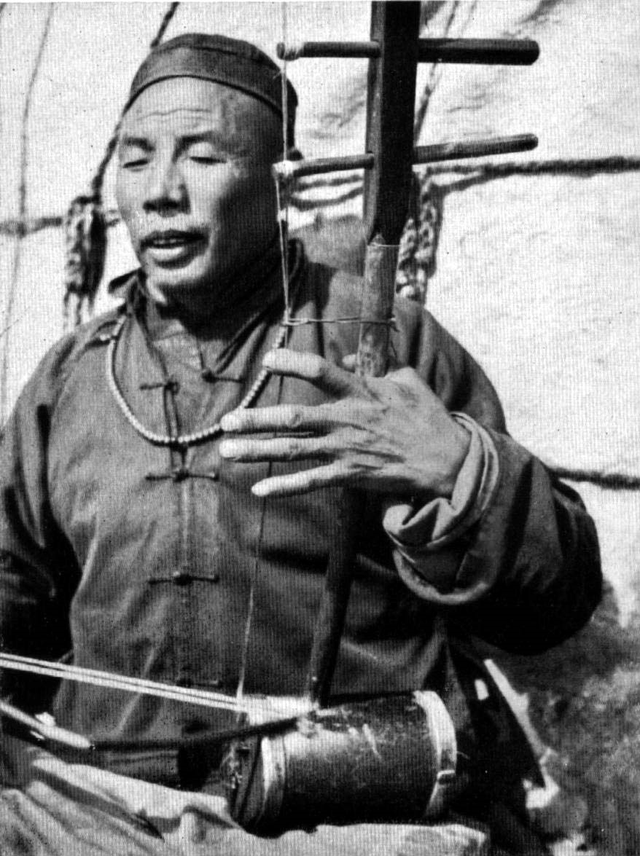
About the first analytic and comparative monograph written on the folk music of the Karachay-Balkar people[88]
Hungarian folk music is closely connected with the music of diverse Turkic peoples. Research into this interaction has already produced considerable results, but it is far from being completed. Intriguing new questions are being raised by continuous inquiry, e.g.: Why is the music of different Turkic ethnic groups so different? Do the linguistic connections of this language family correspond to the musical connections? etc.
The folk music of several Turkic groups has no monographic elaboration so far, and the available publications often fail to answer the elementary questions, too, so it is vitally important to carry on with the expeditions. Only when many tunes have been collected during field work and transcribed, and the work of other researchers has been considered can serious comparative research work begin.
A close study of the material gathered during the expeditions can define the fundamental strata of the music of Turkic-speaking groups and their interrelations, followed by a comparison of diverse folk music, and finally, attempts can be made to draw historical conclusions. It is also to be examined how a highly complex folk music like that of the Hungarians with eastern origins in its old strata is connected to Turkic music and to the music of which Turkic people precisely.
A skeptical reader might butt in that no matter how extensive the field research may be, conclusions as to the Turkic or Hungarian prehistory or ethnogenesis are highly questionable, for a retrospect over thousands of years is hardly more impossible than looking back over a few hundred years in the history of folk music. All we may know is that prior to the organized school system, cinema, radio and particularly television that spread wide in the 20th century, the pace of cultural change was much slower. And that some strata of music, e.g., the laments and the parlando-rubato tunes usually sung in freer rhythm are surprisingly persistent.
It is a generally accepted thesis that the evolution of large comprehensive tune groups requires lots and lots of years, but they usually survive longer, too. Some genres might have a chance to probe into the past, particularly when they are represented by many, different but stylistically connected melodies, constituting a tune layer of style.
Field-research based examination of the archaic elements of Hungarian folk music has time-honored traditions in Hungary. Just to mention the most important ones: Béla Bartók (1976, 1991) carried on field work in Turkey in 1936, and László Vikár (1971, 1979, 1989 and 1999) conducted comparative musical research in the Volga-Kama region among Finno-Ugrian and Turkic groups of people in the company of linguist Gábor Bereczki for over twenty years.
I joined this line of research some 24 years ago. In 1987-93 I spent six years in Turkey where I collected about 1500 tunes and examined another 4000, and on this basis, I could be the first to outline a comprehensive picture of the complex musical styles I found there and their implications for Hungarian music. The next step was to examine the folk music in the area between Anatolia and the Volga-Kama region through my Caucasian, Kazakh, Azeri and further Turkish expeditions. An insight into areas more to the east was ensured by my research trips among the Kyrgyz, Turkmen, and Mongolian Kazakh people.
By now, a collection of over ten thousand tunes – most of them videotaped – and interviews and photos has been accumulated. This collection is found in the Archive of the Institute for Musicology of the Research Center for the Humanities (Hungarian Academy of Sciences) and is integrated to Béla Bartók’s Anatolian collection and László Vikár and Gábor Bereczki’s collection in the Volga-Kama region. So far, I have published several books as the outcome of my research, this one being the next in the series (references).
The studied ethnic groups are tied to varying degrees to the origins of the Hungarians. One example is that of the Kazakhs: some of the Cumans who migrated westward merged with the Magyars while their tribes left in Asia took part in the ethnogenesis of the Kazakhs (Golden 1992). Of equal importance is the North Caucasus where the ancestors of the Hungarians and those of the Karachays lived together in the territory of the Khazar Empire for some time before the Hungarian conquest of the Carpathian Basin (Róna-Tas 1999).
Obviously, I could not undertake the accurate mapping of the ethnically and linguistically highly diverse Caucasus as a whole. In the North Caucasus I did field research mainly among the Karachays and in the South Caucasus in Azerbaijan, in both regions among minorities. I complemented the North Caucasian collection with an important control material. In the late 19th and early 20th century masses of Karachay people fled to Turkey from the Russians. The deportation in 1944 of Caucasian groups to Inner Asia triggered off a new wave of exodus from the Caucasus southward. Unlike other, rapidly assimilating minorities of Turkey, the Karachays living mainly around Konya and Eskişehir still cherish their traditions. The musical culture of this group is also examined in this volume.
In Chapter One I briefly survey the expeditions whose aim was the exploration of the eastern connections of Hungarian folk music. Next, I touch on the earlier field trips to the Caucasus which go back as far as the Dominican monk Otto’s journey in 1232, followed by Frater Julian’s and much later by the Zichy (1987) expedition. Since then, no important Hungarian research has been undertaken in the region and the ones that targeted the area mainly traversed the southern part of the Caucasus (Tardy 1988). I am going to give a short account of our field trips among the Karachays to acquaint the readers with the studied group and the musical and cultural concepts necessary for the understanding of the analytic section and first of the lyrics.
In Chapter Two the emergence and eventful history of the Karachay people can be read about from the beginnings to the mass emigration fleeing the Soviet expansion in the early 20th century and the deportation of the entire ethnicity in 1947 up to the present day. The earlier Russian and European travelers’ accounts about their social life, stratification, old customs, songs and deities are also evoked.
In Chapter Three the reader gets the description and classification of Karachay tunes, together with links to the music of other Turkic groups. It is to be stressed that no synthesis like this of Karachay folk music has been written before, an anthology is Otarov (2001). An important achievement of the analysis is the introduction of the collected 1200 tunes via a selection of 60 melodies after an acquaintance with which most of the rest of the tunes will appear familiar. That has great relevance to education, scientific comparison, and cognition as well. The relations between Hungarian and Karachay folk music are also examined.
Chapter Four contains the scores of 287 tunes with lyrics that well represent the total of 1200 songs. For musically illiterate people the appended DVD will make this chapter more enjoyable with a selection of the recordings of the presented 350 tunes. Musical specialists can get a glimpse of the practical manifestations of the tune types introduced in the previous chapter.
Chapter Five describes the Karachay language and the lyrics with an introduction of the ethnographic background. The song texts in standardized Karachay and their English translation are given in this chapter. In addition to the bibliography, the supplements also include a DVD with a sample of tunes.
We do hope that the book will be of use for historians, Turkologists, linguists and the wider public, apart from comparative folk music researchers and ethnomusicologists.
Summary
There are several cases when the kinship between Hungarian and Karachay music does not concern larger groups of tunes but displays sporadic similarities. It would far exceed the purview of this book to present all of them. However, a short statistic is worth mulling over.
One third of the 357 Karachay tunes that reliably represent the whole collection can be compared to Hungarian analogies, sometimes several tunes resembling a Karachay melody. The studied Karachay tunes thus have 240 Hungarian parallels. About half the analogies are convincing, the rest displaying similar melody progressions in other modes, or being analogous in other respects.
All this confirms a very close musical relationship between the Hungarian and the Karachay stocks, but as the parallel melodies exemplified above have evinced, there is no identity found. Nonetheless, it gives ample food for thought to consider the close similarities in melody lines, modes, rhythmic formulae, etc. Even if the ancestors of these tunes had been closer to one another in times of yore, they certainly would have changed at least as much as they are different now over the millennium that has passed since.
To be able to draw further conclusions, it would be imperative to get a deeper insight into the folk music of the neighbors of the Karacsays, first of all the Ossetian, Kabard and Cherkess people, since the similarity of several musical layers can be discerned between their music and the music of the Karachay-Balkars. Many items in the most prevalent Karachay-Balkar djir tune class have Kabard analogies in addition to the Hungarian parallels, although the Kabards presumably have nothing to do with the Hungarians’ ethnogenesis apart from the ethnonym itself.
Our research has proven again that the music of individual ethnic groups cannot be examined independently of one another. Correct inferences can only be drawn from the comparative research of the culture of peoples living in vast areas.
References
AHM1 Azerbaycan Halq Mahnıları Vol. 1, ed. Bülbül Memmedov. Baku, 1977.
AHM2 Azerbaycan Halq Mahnıları Vol. 2, ed. Bülbül Memmedov. Baku, 1982.
BEL Beliaev, V. M. (1975), Central Asian Music, Middletown, Connecticut
BÖ1 Bayan Ölgiy kazaktarïnïŋ dombra yene sïbïzgï kuileri, Ölgiy, 1977.
BÖI Szőllősy András (ed.) (1966), Bartók összegyűjtött írásai, Budapest: Zeneműkiadó Vállalat.
DSZ Dobszay László – Szendrei Janka (1977), Szivárvány havasán. A magyar népzene régi rétegének harmadik stíluscsoportja, In Vargyas Lajos (ed.) Népzene és zenetörténet 3, Budapest: Editio Musica, 5-101.
DSZ I. Dobszay László – Szendrei Janka (1988), A Magyar Népdaltípusok Katalógusa I, Pszalmodizáló stílus, MTA Budapest: Zenetudományi Intézet.
DSZ III. Dobszay László – Szendrei Janka (1988), A Magyar Népdaltípusok Katalógusa III, Kisambitus – régi stílus, Budapest: MTA Zenetudományi Intézet.
EV Evengki arad-un daγuu, Köke Qota, 1983.
KA1 Mongolija qazaqtarïnïŋ halïq änderi, Bayan Ölgiy, 1983.
KAZ Mongolija Kazaktarïnïn Halïk Ĵïrlarï, Bayan Ölgiy, 1983.
MNT Magyar Népzene Tára.
MO1 Ĵoo-uda arad-un daγuu, Köke Qota, 1981.
MO2 Öbör mongγol-un arad-un keblel-ün qoriy-a, Köke Qota, 1981.
MO3 Aju bayindal jang jangsil-un daγuu, Köke Qota, 1981.
MOE Mongγol arad-un mingγan daγuu 2, Köke Qota, 1981.
MOSH Emsheimer, Ernst (1943), Music of Eastern Mongolia (collected by Haslund-Christensen). In Reports from the scientific expedition to the north-western provinces of China under the leadership of dr. Sven Hedin, VIII. Ethnography 4, The Music of the Mongols, Stockholm: Tryckeri A. B. Thule.
TRT Music sheets of the Turkish Television and Radio
TU1 Kyrgyz, Zoja (1992), Pesennaja kul’tura tuvinskogo naroda, Kizil.
TU2 Kyrgyz, Zoja (1993), Ritmy šamanskogo bubna, Kizil.
YUG Yu-gu, tung-xiang, bao-an, tu-zu melodies, Beijing, 1986.
Abraham, Otto – Hornbostel, Erich von (1906), Phonographierte Indianermelodien aus British Columbia, In Boas Anniversary Volume, New York.
Baker, Theodore (1882), Über die Music der nordamerikanischen Wilden, Leipzig, 1882, Reprint edition with English translation by Ann Buckley: On the Music of the North American Indians, The Netherland, 1976.
Bartók Béla (1924), A magyar népdal, In Szőllősy András (ed.) (1966), Bartók összegyűjtött írásai, Budapest: Zeneműkiadó Vállalat, 101-250.
Bartók, Béla (1931), Hungarian Folk Music, London: Oxford Univ. Press.
Bartók Béla (1976, Bp.), Béla Bartók’s Folk Music Research in Turkey, ed. Saygun, Ahmet Adnan, Budapest: Akadémiai Kiadó, 431 p.
Bartók Béla (1991), Küçük Asya’dan Türk Halk Musıkisi (1991), İstanbul: PAN Yayıncılık, 319 p. 2nd ed. 2017.
Bartók, Béla (1976), Turkish Folk Music from Asia Minor (ed. Suchoff, Benjamin), Princeton, London: Princeton University Press.
Bartók, Béla (2002), Turkish Folk Music from Asia Minor, Homosassa, Florida: Bartók Records.
Beliaev, Viktor M. (1975), Central Asian Music: Essays in the History of the Music of the Peoples of the U.S.S.R., Middletown, Connecticut: Wesleyan University Press.
Bierhorst, John (1979), A Cry from the Earth, New York: Four Winds Press.
Boas, Francis (1888), The Central Eskimo, Washington.
Buttree, Julia M. (1930), The Rhythm of the Redman, New York: The Ronald Press Company, p. 192.
C. Nagy Béla (1947), Mongol népdalok. In Énekszó 14. 5–6.
C. Nagy Béla (1959), Adatok a magyar népdal kialakulásához. Zenetudományi Tanulmányok VII., 605-688.
C. Nagy Béla (1947), A magyar népdal eredete, Zenei Szemle 1947, 203-213.
Cringan, Thom Alexander (1899), Music of the Pagan Iroquois, Archaeological Reports, Appendix to the record of the Minister of Education, Toronto, 166-180.
Csajághy György (1998), A magyar népzene bölcsője: kelet, Pécs: Alexandra.
Curtis, S. Edward (1907-1930), The North American Indian, 20 vol., Norwood, Mass.
Curtis-Burlin, Natalie (1907), The Indians’ book, New York and London.
Densmore, Francis (1918), Teton Dakota Music, Bulletin No 61 of the Bureau of American Ethnology, Washington D. C.
Densmore, Francis (1927), The study of Indian Music in the Nineteenth Century, In American Anthropologist 29.
Densmore, Francis (1926), The American Indians and their Music, New York.
Dobszay László (1983), A siratóstílus dallamköre zenetörténetünkben és népzenénkben, Budapest: Akadémiai Kiadó.
Dobszay László – Szendrei Janka (1988), A magyar népdaltípusok katalógusa, Budapest: MTA Zenetudományi Intézet.
Dobszay, László – Szendrei, Janka (1992), The Catalogue of the Hungarian Folksong Types Arranged According to Styles I, Budapest: MTA Zenetudományi Intézet.
Frederic Webb (1969), Handbook of American Indian North of Mexico, New York: Pageant Book.
Frisbie, Charlotte Johnson (1980), Vocables in Navajo Ceremonial Music, EthM, XXIV, 347-392.
Futaky István (2001), Nyelvtörténeti vizsgálatok a kárpát-medencei avar-magyar kapcsolatok kérdéséhez, Budapest: Universitas Kiadó.
Golden, Peter B. (1992), An introduction to the history of the Turkic peoples: Ethnogenesis and state-formation in medieval and early modern Eurasia and the Middle East, Wiesbaden: Harrassowitz.
Gong, Q. (1995), Közös nevező, China Daily Jun. 19, Peking.
Halasi-Kun, Tibor (1991), Kafkasya (Etnik-Tarihî Bir Araştirma), Kuzey Kafkasya 15:1, 83-84, 15:2, 45-51.
Halikov, Alfred Hasanovič (1978), Proishoždenie tatar Povolžja i Priural'ja, Kazan: Tatknigizdat.
Halikzade, Fettah (1997), Azerbaycan’da Yar-Yar Dügün Mahnilari, V. Milletlerarasi Türk Halk Kültürü Kongresi – Halk Müzigi Oyun Tiyatro Eglence Seksiyon Bildirileri, Ankara: Kültür Bakanligi Yayinlari.
Harmatta János (1983), Az avarok nyelvének kérdéséhez, Antik Tanulmányok 30, 78-84.
Hazai, György (ed.) (1990), Handbuch der türkischen Sprachwissenschaft 1, Budapest: Akadémiai Kiadó.
Halmos István (1979), The Music of the Nambicura Indians (Mato Gross, Brazil), Acta Ethnographica Academiae Scientarium Hugarisae, Tomus 28 (1-4), 205-350.
Hesenov, K. (1988), Azerbaycan Gedim Folklor Regsleri, Baku.
Herzog, George (1928), Musical Styles in North America, Proceedings of the 23rd International Congress of Americanists, 455-458.
Herzog, George (1938), A Comparison of Pueblo and Pima Styles, Journal of American Folklore, 49.
Hirshberg, D. K. (1917), Rhythm of Indian Songs, Musician, April 1917, 257.
Hodge, Frederick Webb (1969), Handbook of American Indian North of Mexico, New York: Pageant Book, Inc.
Hoppál, Mihály - Sipos, János (2010), Shaman Songs, Budapest: International Society for Shamanistic Research.
Isazade, Ahmet – Memmedov, Neriman (1975), Azerbaycan halk mahnilari ve oyun havalari, Baki: Elm.
Jurrens, James Williams (1965), The Music of the Dakota Indian of the Rosebud reservation in South Dakota and Its Use in the Elementary School (Research Study No. 1), Colorado State College, Greeley, Colorado.
Kapronyi Teréz (1981), Jellegzetes motívumok iraki gyermekjátékok és mondókák dallamaiban, Zenetudományi Dolgozatok 1981, Budapest: MTA ZTI, 315-329.
Kyrgyz, Zoya (1975), Tuva ulustuŋ kožambıktarı, Kyzyl: Tuvai Nyelv és Irodalomtudományi Intézet.
Kyrgyz, Zoya (1992), Pesennaja kul'tura tuvinskogo naroda, Kyzyl.
Ključarev, A. C. (1955), Tatar halïk köyleri, Kazan.
Kodály Zoltán (1937-1976), A Magyar Népzene, Budapest: Editio Musica, 1st edition in 1937.
Krader, Lawrence (1966), Peoples of Central Asia, The Hague: Indiana University Publications.
Ligeti Lajos (1986), A magyar nyelv török kapcsolatai a honfoglalás előtt és az Árpád-korban, Budapest: Akadémiai Kiadó.
Matthews, Washington (1892), Navaho Legend, New York.
Mooney, James (1896), The Ghost-Dance Religion and the Dakota Outbreak of 1890, Washington.
Nettl, Bruno (1954), North American Indian Musical Styles, In Memoirs of the American Folklore Society, Vol. 45, Philadelphia.
Nigmedzjanov, Mahmut (1970), Tatarskie narodnye pesni, Moskva: Vsesojuz. Izd.vo Sov. Kompozitor.
Nigmedzjanov, Mahmut (1976), Tatar halik jirlari, Kazan.
Nigmedzjanov, Mahmut (1983), Tatarskie narodnye pesni, Kazan: Tatarskoje knižnoe izd.
Nurmuhamedov, M. K. [et al.] (1971), Karakalpaki, Taškent.
Oransay, Gültekin (1971), Türk halk ezgilerini çözümleme yöntemi, Ankara: TRT Yayinlari I.
Oransky, Iosif Mikhalovič (1960), Vvedenie v iranskuju filologiju (Introduction to Iranian philology), Moskva: Nauka.
Otarov, Omar (2001), Karaçay ‒ Malkar Halik ǰirla, Nalčik: Elbrus.
Ördög László (1997), Ének-zene az általános iskolák 6. osztálya számára. Budapest: Nemzeti Tankönyvkiadó.
Powers, William K. (1990), War Dance, Plains Indians Musical Performance, Tucson and London: University of Arizona Press.
Rajeczky Benjamin (1969), Gregorián, népének, népdal, Magyar Zenetörténeti tanulmányok II., 45-64.
Rhodes, Willard (1952), North American Indian Music, Notes, 10 (1952), 33-45.
Roberts, Heffron Helen (1933), Form in Primitive Music, New York.
Roberts, Heffron Helen (1936), Musical Areas in Aboriginal North America, New Haven.
Róna-Tas András (1996), A honfoglaló magyar nép, Budapest: Balassi Kiadó.
Róna-Tas, András (1999), Hungarians and Europe in the Early Middle Ages. An Introduction to Early Hungarian History, Budapest: Central European University Press.
Saygun, Ahmet Adnan (1976), Béla Bartók’s Folk Music Research in Turkey, Budapest: Akadémiai Kiadó.
Sinor, Denis (1979-1980), Samoyed and Ugric Elements in Old Turkic, Harvard Ukrainian Studies 3-4, 768-773.
Sipos János’ publications are given below separately.
Stumpf, Carl (1886), Lieder der Bellakula Indianer, Vierteljahrschrift für Musikwissenchaft, 2.
Szabolcsi Bence (1934), Népvándorláskori elemek a magyar népzenében, Ethnographia XLV, 138-156.
Szabolcsi Bence (1949), A makámelv a népi és művészi zenében, Ethnographia LX, 71-87.
Szomjas-Schiffert György (1976), A finnugor zene vitája I-II, Budapest: Akadémiai Kiadó.
Tardy Lajos (1988), Kaukázusi magyar tükör, Budapest: Akadémiai Kiadó.
Tervonen, Viljo (1943), Heimotyösta Unkarissa talvikautena 1942-43, Heimokansa 1943/6-8, 33-36.
Väisänen, Armas Otto (1937), Vogulische und Ostjakische Melodien, Mémoires de la Société Finno-Ougrienne LXXII, Helsinki.
Vargyas Lajos (1953), Ugor réteg a magyar népzenében, Zenetudományi tanulmányok I, 611-657.
Vargyas Lajos (1980), A magyar zene őstörténete I-II, Ethnographia XCI, 1-34, 2, 192-236.
Veszprémi László (1996) (ed.), Honfoglaló őseink. Budapest.
Vikár, László (1987) - Collection of Finno-Ugrian and Turkic Folk Music in the Volga-Kama-Belaya Region (1958-1979). In Studia Musicologica 29: 355-422, Budapest: Akadémiai Kiadó.
Vikár László (1993), A volga-kámai finnugorok és törökök dallamai, Budapest: MTA ZTI.
Vikár, László – Bereczki, Gábor (1971), Cheremiss Folksongs, Budapest: Akadémiai Kiadó.
Vikár, László – Bereczki, Gábor (1979), Chuvash Folksongs, Budapest: Akadémiai Kiadó.
Vikár, László – Bereczki, Gábor (1989), Votyak Folksongs, Budapest: Akadémiai Kiadó.
Vikár, László – Bereczki, Gábor (1999), Tatar Folksongs, Budapest: Akadémiai Kiadó.
Wiora, Walter (1956), Älter als die Pentatonik, in Studia Memoriae Belae Bartók Sacra, Budapest: Academia Scientiarum Hungaricae, 185-208.
Wiora, Walter (1965a), The Four Ages of Music (orig. ed in Germany by W. Kohlhammer, Stuttgart: Die vier Weltalter der Music), New York: Norton.
Wiora, Walter (1965b), Ethnomusicology and the History of Music, Studia Musicologica VII, 187-193.
Voegelin, Charles Frederick – Voegelin, Florence Marie (1966), Map of North American Indian Languages. (American Ethnological Society Publications 20), American Ethnological Society.
Zhang, Rei. Kínában élő népek dalai és a magyar népdalok hasonlóságainak okairól. In Zenetudomány 2, Budapest.
Zichy Jenő (1897), A magyar faj vándorlása, Budapest: Ranschburg G.
Bibliography of János Sipos
For Internet access of János Sipos’s publications see www.zti.hu/sipos
Books
Sipos János (1994), Török Népzene I, Budapest: MTA Zenetudományi Intézet, 412 p.
Sipos János (1995), Török Népzene II, Budapest: MTA Zenetudományi Intézet, 426 p.
Sipos János (1999), Bartók Béla törökországi gyűjtése egy nagyobb anyag fényében, PhD manuscript, 230 p.
Sipos, János (2000), In the wake of Bartók in Anatolia (Bibliotheca Traditionis Europea 2), Budapest: European Folklore Institute, 350 p.
Sipos, János (2001), Kazakh Folksongs from the Two Ends of the Steppe, Budapest: Akadémiai Kiadó, 302 p.
Sipos János (2002), Bartók nyomában, Anatóliában - Hasonló magyar és török dallamok, Budapest: Balassi Kiadó, 201 p.
Sipos János (2004), Azeri Folksongs: At the Fountain-Head of Music, Budapest: Akadémiai Kiadó, 625 p.
Sipos, János (2005), In the wake of Bartók in Anatolia (CD-ROM), Budapest: European Folklor Center.
Sipos, János (2005), Comparative Research on the Folk Music of Turkic and Hungarian People, Ankara: TIKA and the Hungarian Embassy in Ankara, 280 p.
Sipos, János (2005), Azerbaycan El Havalari: Musiqinin Ilkin Qaynaqlarinda, Baki: Ebilov, Zeynalov ve Ogullari, 603 p.
Sipos János (2009), Azerbajdzsáni népzene - a zene forrásainál, Budapest: Eurpopan Folklor Centre – l'Harmattan, 475 p.
Sipos János (2009), Anadolu'da Bartók'un İzinde, İstanbul: Pan Yayıncılık, 220 p.
Sipos, János (2009), Azerbajdzsáni népdalok – a zene kezdeteinél, Budapest: Institute for Musicology - European Folklore Institute.
Sipos, János (2014), Kyrgyz Folksongs, Budapest: l'Harmattan, 416 p.
Sipos János (2019), Keleti hatások és motívumok a magyar művészetben, Budapest: MMA Kiadó.
Sipos János (2019), Bartók Béla, Török Népzene Kis-Ázsiából, Budapest: l’Harmattan, 274 p.
Sipos János, (2020), Bartók Anatóliában, Írások Bartók Béla Kis-Ázsiai gyűjtéséről, Budapest: MMA Publishing House, 350 o.
Sipos, János - Csáki, Éva (2009), The Psalms and Folk Songs of a Mystic Turkish Order: The Music of Bektashis in Thrace, Budapest: Akadémiai Kiadó, 665 p.
Sipos János – Ufuk Tavkul (2012), A régi magyar népzene nyomában: a kaukázusi karacsájok népzenéje, Budapest: l'Harmattan, 427 p.
Sipos, János – Ufuk, Tavkul (2015), Karachay-Balkar Folksongs, Budapest: l'Harmattan, 427 p.
Sipos, János – Ufuk, Tavkul (2018), Karaçay-Malkar Halk Şarkıları, Ankara: Bengü, 463 p.
Hoppál, Mihály - Sipos, János (2010), Shaman Songs, Budapest: International Society for Shamanistic Research, 72 p.
E-books
Sipos, János (2017), Kyrgyz Folksongs, Budapest: l'Harmattan – MTA BTK (Institute for Musicology), Budapest,
http://media.harmattan.hu/webbook/sipos-kirgiz/index.html
Sipos, János (2020), In the Wake of Bartók in Anatolia, Budapest: Institute for Musicology,
www.zti.hu/sipos_ebook/bartok/bartok_en.htm
Sipos, János (2020), Kazakh Folksongs, Budapest: Institute for Musicology,
http://zti.hu/sipos_ebook/kazakh/kazakh.htm
Sipos János (2019), Bartók Béla, Török Népzene Kis-Ázsiából, Budapest: Institute for Musicology & Gül Baba Örökségvédő Alapítvány, Budapest: l’Harmattan,
http://www.bartok-torok-gyujtes.hu/
Sipos János (2020), Anatóliai Népzene 1, Budapest: Institute for Musicology,
www.zti.hu/sipos_ebook/anatoliai/vol1.htm
Sipos János (2020), Anatóliai Népzene 2, Budapest: Institute for Musicology,
www.zti.hu/sipos_ebook/anatoliai/vol2.htm
Sipos János (2020), Bartók nyomában, Anatóliában, Budapest: Institute for Musicology,
www.zti.hu/sipos_ebook/bartok/bartok_hu.htm
Sipos, János (2020), Anadolu’da Bartók’un izinde, Budapest: Institute for Musicology,
www.zti.hu/sipos_ebook/bartok/bartok_tr.htm
Sipos János (2019), Bevezető, hangok és kották a Bartók Béla, Török Népzene Kis-Ázsiából (e-könyv), Budapest: Institute for Musicology & Gül Baba Örökségvédő Alapítvány, Budapest: l’Harmattan.
www.bartok-torok-gyujtes.hu
Sipos, János – Tavkul, Ufuk (2015), Karachay-Balkar Folksongs, Budapest: l'Harmattan,
https://media.harmattan.hu/webbook/Sipos-Karacsaj/sjk.html
Endnotes
1 Saygun (1936), Türk Halk Musikisinde Pentatonizm, Nümune Matbaasi
2 We recorded songs at the following places. 1999: Çorlu, Musulça, Tekirdag, Kilavuzlu, Karacakilavuz and Istanbul (170 melodies); 2001: Izmirben and Özdere (18 melodies); 2002: Tekirdag, Kilavuzlu, Yeni Bedir, Çeşmekolu, Kirklareli, Karincak, Kizilcikdere, Lüleburgaz and Istanbul (208 melodies); 2003 spring: Kirklareli, Kizilcikdere, Devletliagaç and Ahmetler (235 melodies); 2003 summer: Kirklareli, Topçular, Devletliagaç, Enez, Ormankent and Zeytinburnu (Istanbul) (250 melodies). Besides, we got lots of recordings from other people.
3 Exceptions are e.g., the melodies built up of motives rotating on G-A-H(b) trichord, religious melodies with low moving first and last sections and higher middle sections etc.
4 At the same time the religious zikr melodies are usually simple; true they are a sort of dancing melodies, as the Bektashis turn they semah on these songs.
5 Similarly simple are the twin bar melodies, so I handle them separately.
6 Inside these groups some melody belongs to different musical words despite of the small compass and simple forms.
7 Naturally now I can introduce only a few characteristic forms. The detailed analysis will be published in Sipos-Csáki, Psalms and Folksongs of the Bektashis in Thrace.
8 Different is a domed form, with low beginning and closing lines and higher middle sections. Most of these melodies are hymns.
9 The third section usually descends to A.
10 The characteristic feature of the 1st group are the b3(4)x and 4(4)x cadences, and that of the 2nd group the 4(b3)b3/1 and 5(b3)b3/1 cadences. Although we see sequential phenomenon in the melodies of the 2nd group, the melodies with sections following each other descending sequentially belongs to the 3rd group.
11 These melodies are widespread and popular in Turkey. As I have discussed the similarity of Hungarian and Anatolian musical styles and their international relations as well, I will not deal with it now (Sipos 1994, 2000, 2002).
12 I found two Tatar tunes of this pattern, but they are exceptions among the 1200 (also pentatonic) tunes (Nigmedzianov 1970, 1976, 1983 and Vikár-Bereczki 1999).
13 In Rumanian folk songs in Transylvania, we find parallels to almost each melody of old Hungarian musical styles. This is not an accident after such a long coexistence of Hungarians and Rumanians in this area (Domokos-Paksa 1982, Magyar–román dallamkapcsolatok Bartók román gyűjteményében. In Népzene és zenetörténet, Vol. 4, Budapest, 5–109). There are lots of similar Major melodies in the Slovakian material.
14 American Indians do not like this theory because it contradicts their myths. Of reason of this disliking is that if they had come from another continent, they could have been treated as immigrants.
15 Bruno Nettl (1954), North American Indian Musical Styles, Philadelphia, American Folklore Society
16 Béla Bartók in Turkey (1936); László Vikár and Gábor Bereczki among Finno-Ugrian and Turkic ethnic groups living in the Central Volga Region (1958-1979).
17 Sipos (1994, 1995, 2000, 2001, 2002, 2004)
18 One division of the main areas is as follows: 1. Eastern Woodlands, 2. Great Plains (northern and southern), 3. Southwest, 4. Great Basin, 5. California-Yuman, 6. Northwest Coast, 7. Arctic. See also George Herzog (1928), Helen Roberts (1936) and Bruno Nettl (1954)
19 Many contemporary melodies sung in powwows and the reservations moves on the (C')-A'-G'-E-D-C-A la-pentatonic scale.
20 We might use triplets or changing 2/4- and 3/4-time signatures as well. The special metric and rhythmic freedom of the Dakota songs might be looked upon as a kind of frozen free rhythm. The strict tempo is obligatory because the American Indians often dance while singing these songs. A great variety of meters and rhythmic patterns are possible because the structures of the dances are very free. Dancers do not have to regulate their dance to musical structures, so music has freedom to create rhythmical and structural variations.
21 Seemingly similar is the rhythm of the Valcer of Vienna, but here the function and the inner rhythm of the accompaniment is basically different.
22 The cadence sequences are as follows: E-C-D-A, E-D-C-A, A'-D-D-A, A-E-D-A, A-E-C-A. Let us remember that now we are only discussing melodies moving on A-pentatonic scale.
23 As we saw earlier, Dakota songs do not use the G tone, which plays an important role in Hungarian melodies. In Hungarian melodies sometimes F appears between E and A`, hiding the pentatonic character. In the closing sections of Hungarian melodies Hb can also be heard often.
24 I compared Hungarian, Cheremis, Chuvash, Mongolian and Chinese fifth-shifting styles in detail in Sipos (2001).
25 13 melodies out of the total 200. This portion is much higher in the material I collected in 2004.
26 It is thought provoking that we have found most of the similarities among the four-section songs. It would be more logical to find similarities among songs having simpler forms too.
27 Not counting the jumping up movements at the beginning of some Dakota melody sections.
28 This musical world is more homogeneous and simpler than that of the Hungarian or Anatolian.
29 To Ostyak tunes Szabolcsi (1933) and Vargyas (1953), to Estonian tunes C. Nagy (1959, 1962: 229-240) and Szomjas-Schiffert (1963). The latter tunes are usually strophic and are performed tempo giusto.
30 E.g., do-re-do-la / re-do-(si)-la vagy mi-re do / re-mi-re-do.
31 From among Vargyas’ examples (1953) Dobszay (1983: 50, fn.18) only accepts a few. Further examples are given in Vargyas (2002: 245-252). The dissenting opinions are also connected to the fact that the criteria of folk music styles are not – and probably cannot be – put down with mathematical accuracy.
32 Though some researchers hypothesize the connection between laments and heroic songs (e.g., Vargyas 2002: 253), this is far from being verified. To mention but one example, I collected both genres among the Aday Kazakhs, and compared to the Phrygian tetratonic parlando performed descending (or hill-shaped) laments with two cadences, the character of the terme (heroic) songs has twin-bar character just like among Mongols and Kyrgyz people (Sipos 2001c: 35-41).
33 For its description and comparison with the small form of the Hungarian lament, see Sipos (2001: 43-48).
34 Single core: sol-sol-sol-mi / re-do-do-do // do-mi-do-re /do-do do, cadencing on re/mi: re-mi-re-re / re-re re // re-mi-re-re re m // do-do-do-do / do-mi re / do-mi-re-re / do do. Lots of similar tunes were found in Anatolia, too. With an additional descent: (sol-mi-mi-re do-do-mi-re re-do do + la-la-la la vagy do-do-mi-sol mi-re-mi-do-do + la-la-la la).
35 E.g., MO1 117: la-la-sol-mi sol / mi-re-do-mi re / mi-sol-do-re mi / sol-mi-re do. These tunes are clearly marked off by the typical pentatonic progression from the laments that move conjunctly.
36 The psalmodic style that may be related to the pentatonic laments will be discussed later.
37 There are pentatonic traces, though, see Sipos (2002b: 122-123).
38 E.g., Sipos (2002b: 125-128). Let me mention here that the majority Kabards living in a political unit with the Balkars have a lot of tunes that resemble the small form of the Hungarian lament, e.g., Gippiysa (1990: No. 58-60). These Kabards are not related to the mixed Turkic-Kabard groups arriving in the Carpathian Basin with the Hungarians.
39 Lajos Vargyas compiled the supplement of examples for Kodály’s book. He separates the tunes of the „psalm type” moving on the do-re-mi trichord from tunes joining the mi-re-do strip from high. He does not yet range here no.133 of Kodály (1937-1976) which is very similar to no. 178. Vargyas (2002) also discusses separately the tunes descending to the mi-re-do band from higher, and in Járdányi (1961) the class marked with the do-re-mi beginning is separate and far removed in his system arranged by height relations of lines from tunes that begin reciting high.
40 Thereby the starting tunes of Bartók’s Class A.I. are side by side again, together with tunes of different syllable number and rhythm.
41 Since I devote much thought to the similarities of the Hungarian and Anatolian Turkish psalmodic styles as understood by Dobszay-Szendrei (1977) in three books (Sipos 1994, 2000, 2002), I do not go into detail here. Let me note as much that in the first line of Turkish tunes a double do-re-mi start is rare and degree VII. also plays a smaller but not negligible role in the style. Pentatony is less strict in line with the general Anatolian character: though degree 6 is missing, degree 2 occurs in nearly every tune, even if it often only comes at the end, before the descent to the closing note.
42 It was therefore not accidental that Bartók’s smaller Anatolian collection of 1936 also includes relatively many such tunes.
43 See Sipos (2001c: 48-53). This musical solution is similar but not identical with the psalmodic tunes of other peoples.
44 This Avar musical style displays massive similarity with the Hungarian psalmodic style but is not identical with it. We know that the Avars of the Caucasus are not relatives of the Avars people once living in the Carpathian Basin.
45 See also Saygun (1976: XIII) about Turkish rain magic songs of a similar structure. At the same time, the customs and their music material among my neighbours are different.
46 What is more, among German children’s songs the sol’-la’-sol’-mi motif corresponds to Hungarian tunes, the mi-re-do motif being less frequent.
47 Most Turkish children’s songs are similar (Yönetken 1966). Sipos (1994a: 51) also carries similar Turkish and Hungarian ditties.
48 E.g., the Gollu tune is as follows: fa-fa-fa mi-mi-mi / re-re-re si so / do si-do / re re. That of the Ozay is re re-re do si / do re.
49 Tunes rotating on other cores are not infrequent in the folk music of these peoples Sipos (2014: 51).
50 Bartók listed their typical cadences and noted that the tunes of A5B5AB structure often had variants close to the ABCD form, and vice versa. Bartók discovered the fifth-transposing structure in Slovak folk music and established that Cheremis tunes displayed a peculiar structure, which corresponded to the A5B5AB scheme in essentials. He presented three such tunes in the Appendix (Bartók 1924: 285). "In essentials" meant that all three Cheremis tunes had A4B4AB structure, which acquired the scheme of A5B5AB when the first half was transposed an octave higher. According to László Vikár's on-the-spot observations, these two forms are not separated by the Cheremis, and the pitch of the starting note determines whether A5B5AB or A4B4AB will be sung, and unlike in Hungarian music, the A4B4AB form is more frequent.
51 Although most of his examples are from the Volga region, Kodály did not restrict the possibility of analogies to this area. However, relying on the fifth shifting tunes, the A5BAB and A4BAB forms and other parallel tunes, he concluded that "certain basic elements of music may evolve similarly among different groups of people living far from one another without contact... Such conspicuous essential correspondence of melody structure, phraseology, rhythm as these, however, cannot be a matter of chance. We must presume a common source" (Kodály 1937: 37).
52 There was a long polemic about the genetic relationship of Hungarian and Volga-region fifth transposition. Vikár (1993: 167-168) writes: "Undoubtedly there are a few descending or clearly fifth-shifting Hungarian pentatonic tunes that have close Cheremis or rarely Chuvash analogies. ... is that sufficient ground to conclude that there is direct kinship here?... e.g., the Hungarian 'peacock' motif is simple and natural which might appear, without any special external influence, in the Cheremis, Chuvash, or, for that matter, Mongolian, Celtic or Indian musical language which are so-far known to be exclusively pentatonic." He argues that an area of great migrations like the Volga region cannot easily preserve very old elements, and what is more, the Cheremis people of archaic eastern culture do not know fifth-transposition. He deems it unlikely that a style such as fifth-shifting along the Cheremis-Chuvash border could flourish for millennia. By contrast, Lajos Vargyas (1980: 28) says, "there is such a great degree and mass of similarity between Hungarian and Volga-region fifth-shifting styles and tunes with fifth transposition that they must be attributed to a common origin."
53 Vargyas (1980: 13) writes, "Quite different from the folk music styles of these peoples is the narrow strip of land south of the Volga, along the Cheremis-Chuvash border where broadly arched pentatonic fifth-shifting tunes predominate almost exclusively the music of both ethnic groups."
54 Szabolcsi (1979: 107-109). Of them, Kodály also referred to the Chuvash, Kalmuck and Baikal Mongolian tunes (1939-76: 97).
55 E.g.: Ördög (1997: 114) an Inka folksong from Peru: |: G G G G – F F F D – C C F G - D :| F D C D – B B B A, - G, G, D C - B | F D C D – B B B A, - G, G, D C - G,.
56 C. Nagy (1947: 76, 80-81), Szabolcsi (1979: 107-108), CMPH VIII/A: 12.
57 Since no synthesizing monographs are available of the music of these peoples, it is theoretically possible that there are larger numbers of fifth-shifting tunes where I have not found them. However, the spectacularness of fifth shifting makes it unlikely that none would be included in Turkic folksong collections, which usually omit the simpler tunes.
58 I collected 1500 tunes in Anatolia in 1987-1993 and published three books in connection with my collection (Sipos 1994, 1995, 2000). I have returned there almost every year since, presently studying the music of the Bektashi in Thrace and the Anatolian Karachay people.
59 I collected some 600 tunes among the Azeris, the closest language kin of the Anatolian Turks, in 1999 (Sipos 2004) and studied the available Azeri publications e.g., AHMI-2, Hasanov (1988), Isazade-Mammadov (1975), Krader (1966).
60 In the county of Mangishlak of southwestern Kazakhstan I led a folk music expedition in 1997, on this in detail: Sipos (2001).
61 I have collected some 600 tunes among Karachays in the Caucasus and Turkey. This Turkic group of people might have salient relevant to the prehistory of Hungarians.
62 Sources of the cited tunes: Nigmedzjanov (1970, 1976 and 1983) and Vikár-Bereczki (1999). I collected from Tatars staying in Szeged in 1996.
63 I was acquainted with the folk music of the Kazaks of an archaic culture living in Bayan-Ölgiy (Western Mongolia) from the material of two expeditions and from publications, e.g., KAI 1983.
64 Kirgiz 1992.
65 I have read the available articles of the Chinese musicologist Zhang Rei and his pupil Du Yaxiong, I have studied some 200 Yellow Uyghur tunes and listened to and transcribed the Uyghur tunes in the sound archives of the Institute for Musicology of the Hungarian Academy of Sciences (Zhang 1985, Gong 1995, YUG). Gyula Décsi was kind enough to show me the article submitted by Du Yaxiong for the Ural-Altaische Jahrbücher during the Permanent International Altaic Congress in 1996. Csajághy's argumentation of 1998 about the Hungarian-Uyghur tune analogies does not appear convincing.
66 Typically enough, this very tune was included in Du Yaxiong's cassette of Uyghur music he gave to the Institute for Musicology, HAS, in Zhang Rei's article, and the same was collected from an Uyghur singer at the Hungarian embassy in Peking by the musician László Poros.
67 MOSH, MO1, MO2, MO3. I use the phrase ‘fifth-shifting character’ when I generally allude to tunes with perfect or partial fifth transposition.
68 Ligeti (1933), MOSH
69 29 of the 133 tunes in the EV volume.
70 Published in Sipos (2004).
71 The studied Hungarian pentatonic fifth-shifting tunes are from Kodály (1937), the Chuvash and Cheremis tunes from Vikár-Bereczki (1971, 1979). The Mongolian and Evenki tunes are cited from MOSH, MO1, MO2, and MOE. The similarity between individual tunes is not too informative, but analogies between tune groups may be revealing. Therefore, I only considered tune groups that comprise at least three different melodies conveying the same core idea. Thus, the truly significant musical ideas that take several shapes are more powerfully represented, and the less significant ones are ignored to give salience to the point. It is to remember then that an example to be quoted in the following always represents a tune group of many similar tunes.
72 In this pentatonic style the single G-D step downwards does not cause two hills to appear in the Cheremis and Chuvash tune beginnings. This time the melody line moves between C and B', while in the tunes of the other Turkic groups B' is only included as a grace note.
73 Though the published forms are the typical ones, shorter Cheremis lines can also be exemplified (e.g., Vikár-Bereczki (1971: 270), but even that is more animated than the Hungarian tunes. Let me note, however, that the Hungarian example Kodály cited (1937: 23) (G G D D B' B' A G-G F C) is also jumping up and down over as wide a range as the Cheremis-Chuvash songs, though in the latter an initial G-D step would never occur, starting the tunes normally with a leap upwards.
74 In some cases, line 2 ends on B. Besides, there are Hungarian fifth-shifting tunes with F-D-B cadences whose first line is woven around the note G.
75 E.g., Vikár-Bereczki (1979: 280).
76 Vikár-Bereczki (1979: 303-310)
77 At the time of the Khazar Empire other Turkic peoples living in the foreground of the Caucasus and west of it - i.e., in areas where the Hungarians lived prior to their influx into the Carpathian Basin - also had ancestors from the eastern edge of the steppe. This, in theory, allows for the linking up of the fifth-shifting structure in Inner Asian and Hungarian folk music.
78 It cannot be an ancient Mongolic-Turkic tradition as it does not occur with every Turkic group and besides, it is a highly advanced form.
79 According to Sinor (1967) "there are a lot of demonstrable Mongolic effects in the Finno-Ugric-Chuvash-Turkic basin around the Volga about which, as far as I know, little if anything has been written."
80 Archeological finds have revealed that in the Volga-Kama region and in the Ural the nomadic way of life breeding large livestock appeared in the 4th c. AD, and the Kazan historians associate it with the first settlement of Turkic peoples. At any rate, the Hungarians were certainly reached by the waves of the Hunnish migration.
81 As Constantine writes, these tribes taught the Hungarians their own language, they also learnt Hungarian, and in the 10th century both languages were still in use. Similarly, via a transitional bilingual state did probably the integration of other Turkic and non-Turkic peoples take place.
82 As is known, various peoples including Mongols and Turks lived in the steppe empires. Although the Altaic theory - that hypothesized the Turkic, Mongolic, and Manchu-Tungusic languages as a genetic community - has fewer advocates today, researchers agree that in the course of their history Mongolic, Turkic and Manchu peoples were very closely related.
83 E.g., alma 'apple', búza 'wheat', balta 'axe', gyümölcs 'fruit', oroszlán 'lion', sereg 'army', etc. The majority only lives on as dialect words in both languages, or is extinct. Most researchers opine that in both languages they are Turkic loan words that passed into Mongolian after the long Mongolian-Turkic coexistence, and into Hungarian from a Turkic language related to Black Burghers and to contemporary Chuvash, maybe before the settlement, as the most widely accepted theory claims.
84 Although in 795 Charlemagne did subdue and then destroy the enormous Avar Empire on power for 300 years with its center in the Carpathian Basin, there is information that in 875 close to the Hungarians' influx and settlement the Avars were still living there under their own kagans and in areas which the Franks had not reached - e.g. the Great Plain or beyond the Tisza rover - they were probably even more numerous.
85 Let now me cite Lajos Ligeti's opinion: "Here this language is said to be Turkic since Vámbéry, Pelliot thought it was Mongolic... In view of the duality displayed by the anthropological and material cultural remains of the Avars, it is not unlikely that this duality also existed in the language." He also wrote that "Bayan's Avars actually spoke Mongolic; the rest spoke a peculiar Turkic (of Chuvash?) character" (Ligeti 1986).
86 Presumably "they were to constitute the masses, the bulk of the commoners under the new ruling people, the Hungarians" (Veszprémy 1996).
87 Of course, Turkic influence was received by the Hungarians after their settlement as well. Large crowds of Pechenegs of a Kipchak-Turkic tongue settled in the Hungarian Kingdom in the 11th-12th centuries. Some of the Cumans moved to Hungary in 1239 because of the advancing Mongols. Unfortunately, nothing of these peoples' music survives, or more exactly, there is no knowing what they contributed to the enrichment of the Hungarian folksong stock. The ethnic groups that arrived later also originated along the eastern border zone of the steppe just as the Mongols, other Turkic peoples or Avars, and it was perhaps because some layers in the music of the immigrant Cumans were like the musical strata of the people already living there that no trace of Cuman music has survived e.g., in the Kúnság region of Hungary.
88 Sipos- Tavkul (2012, 2015).






